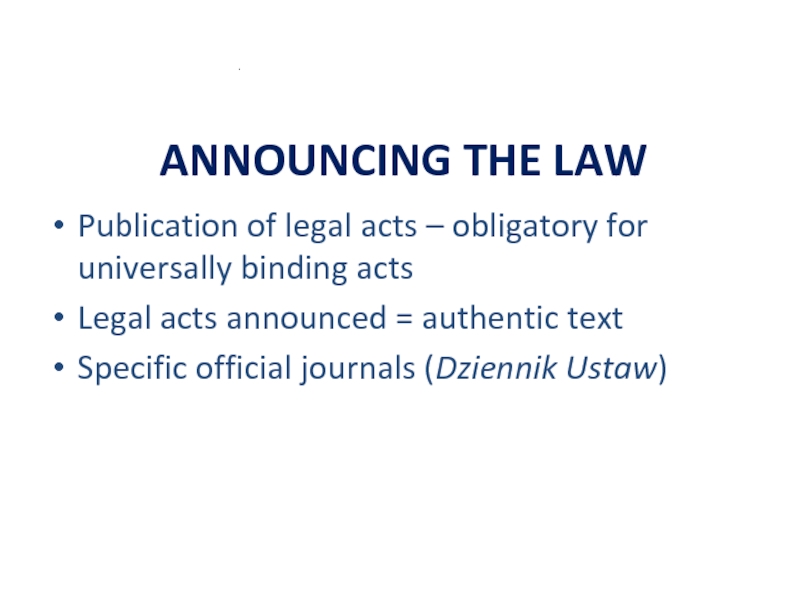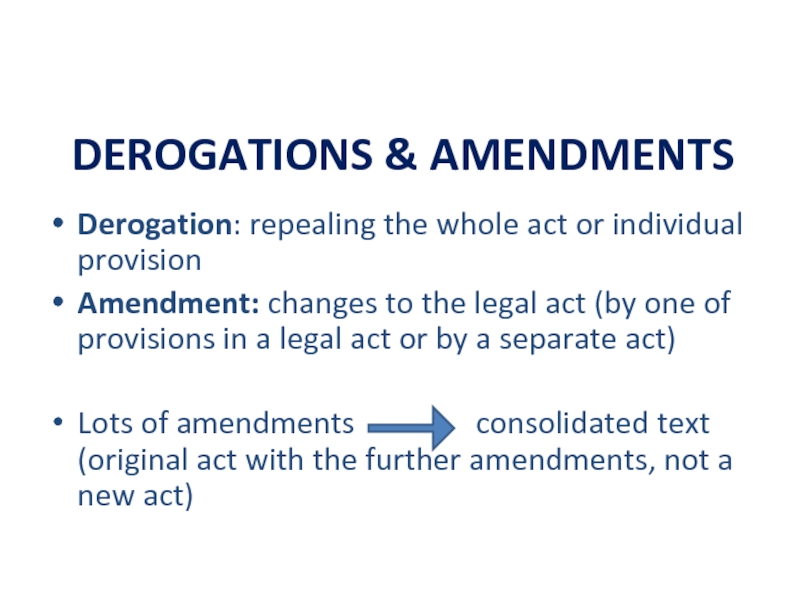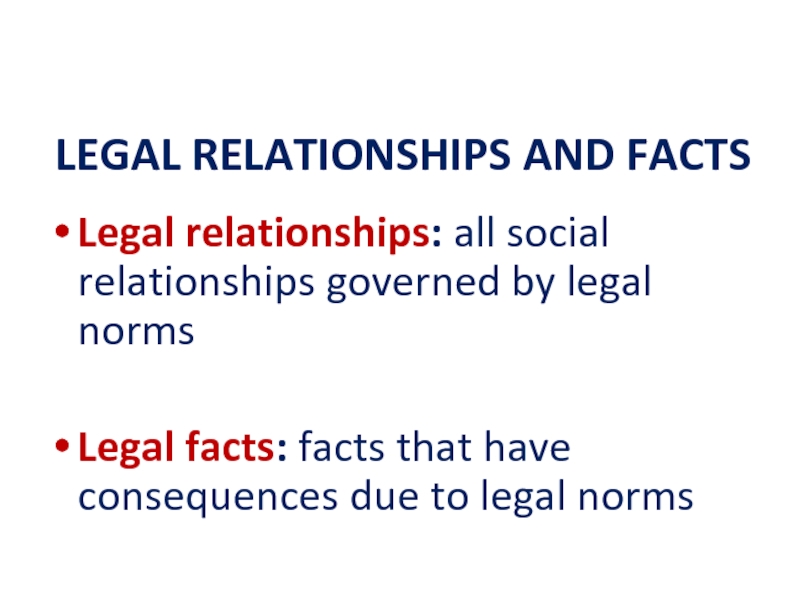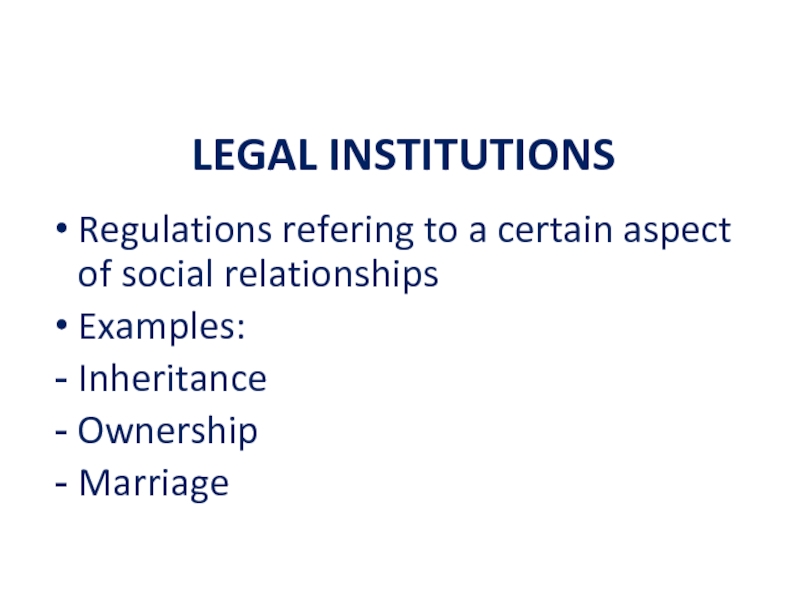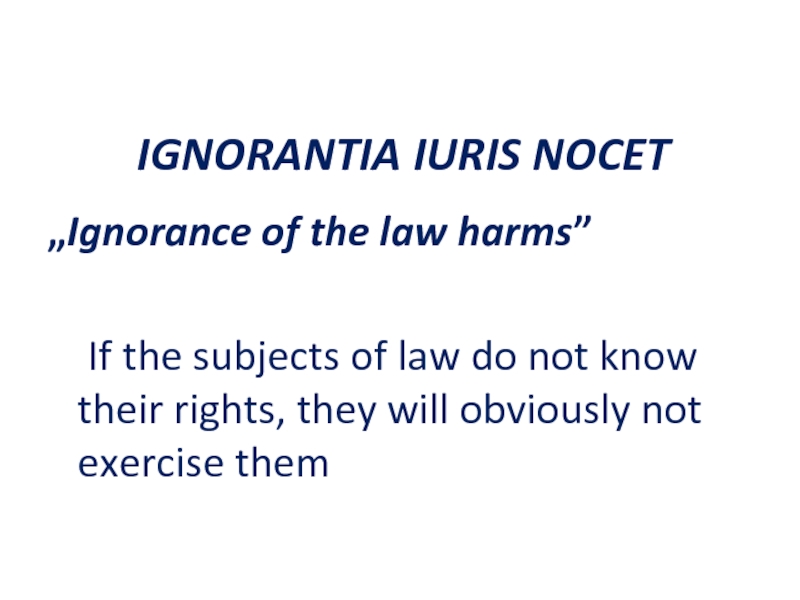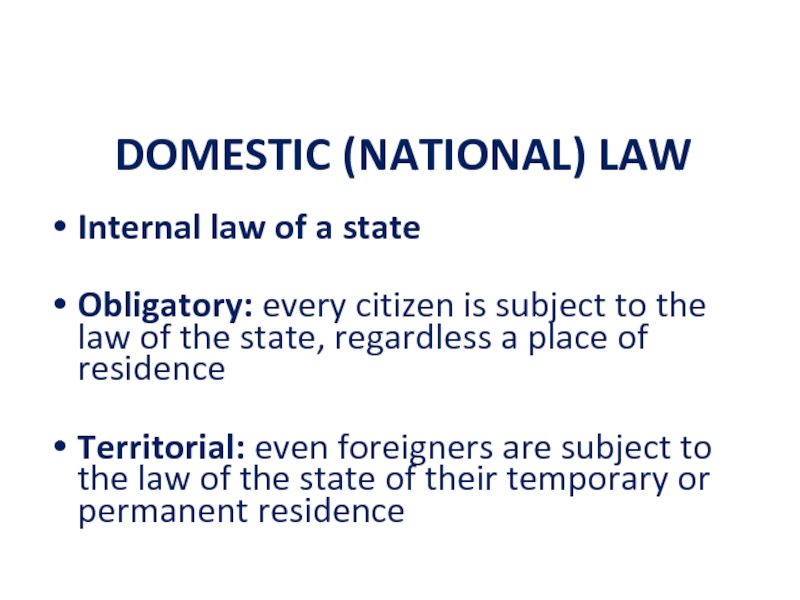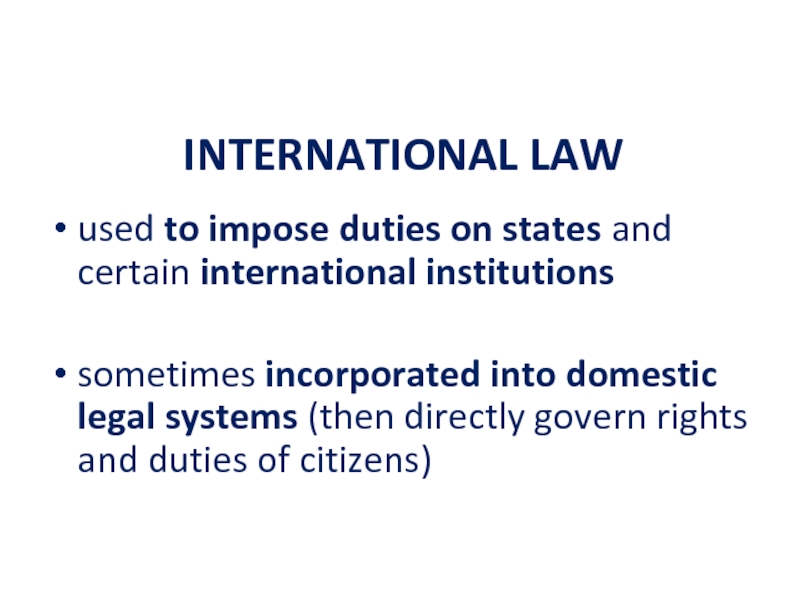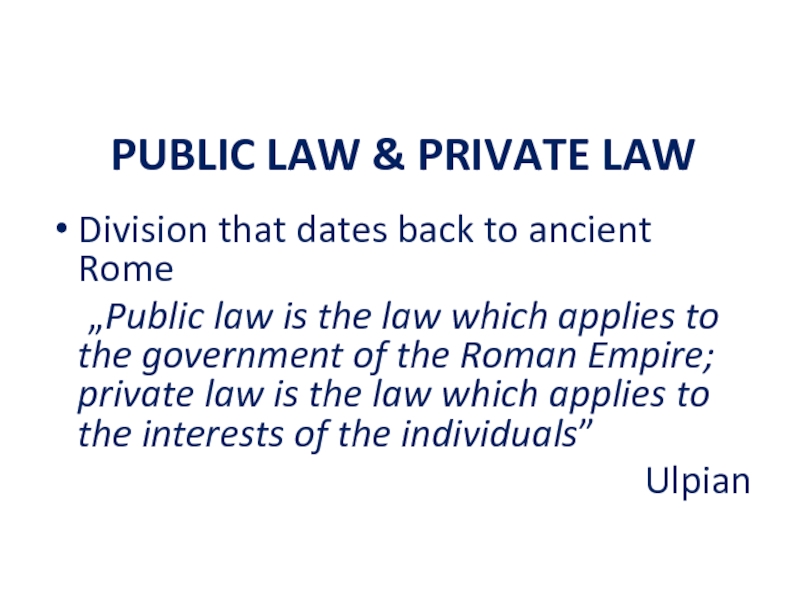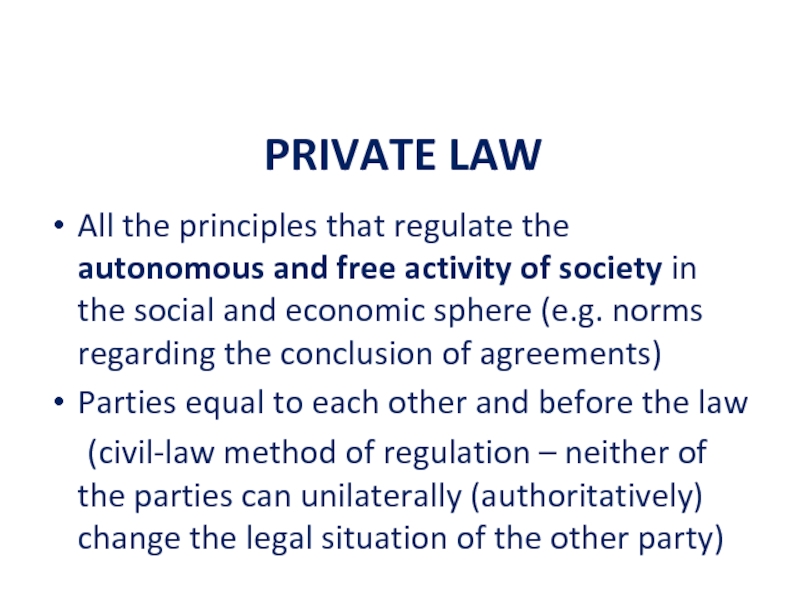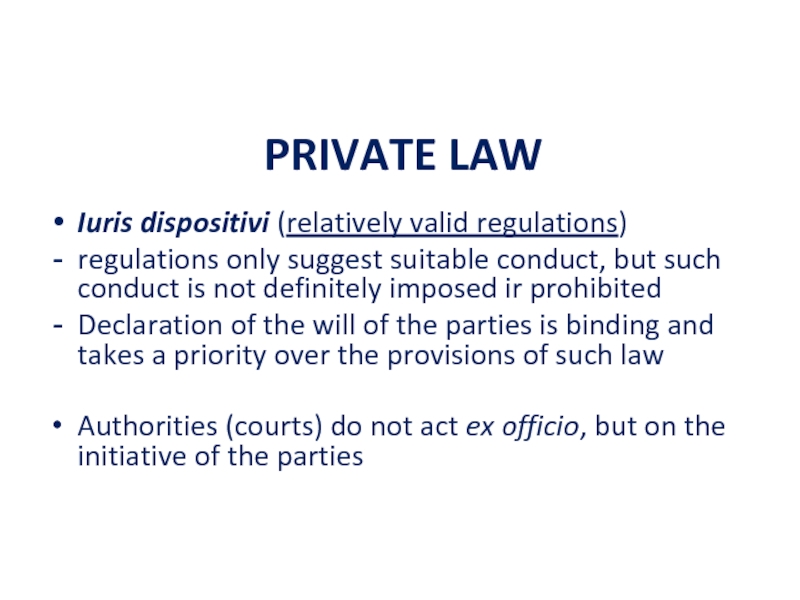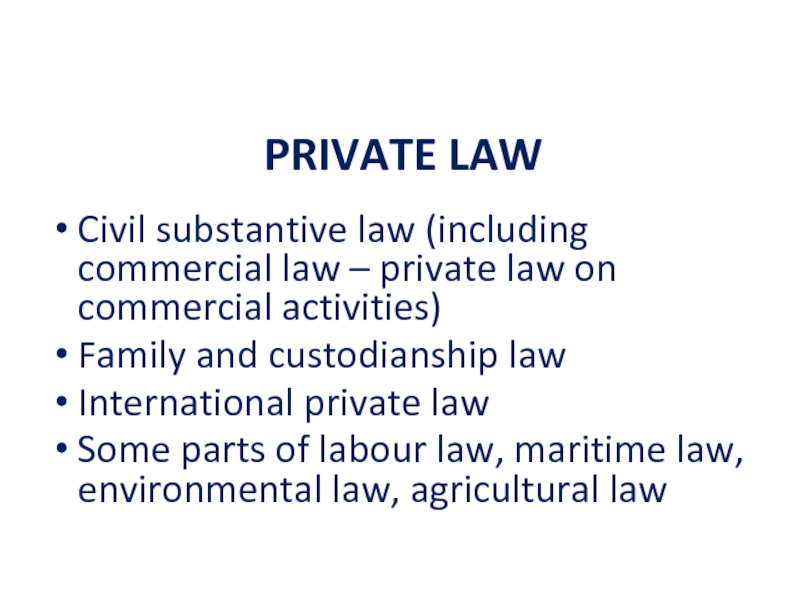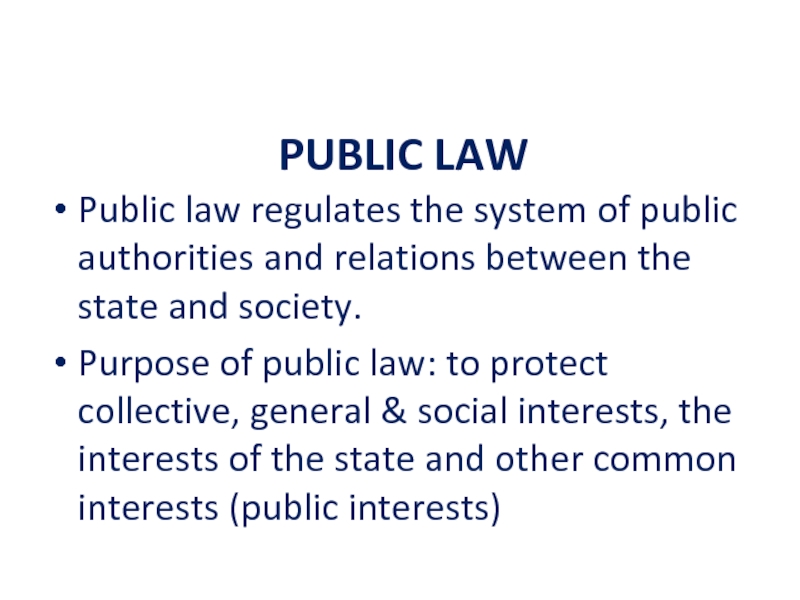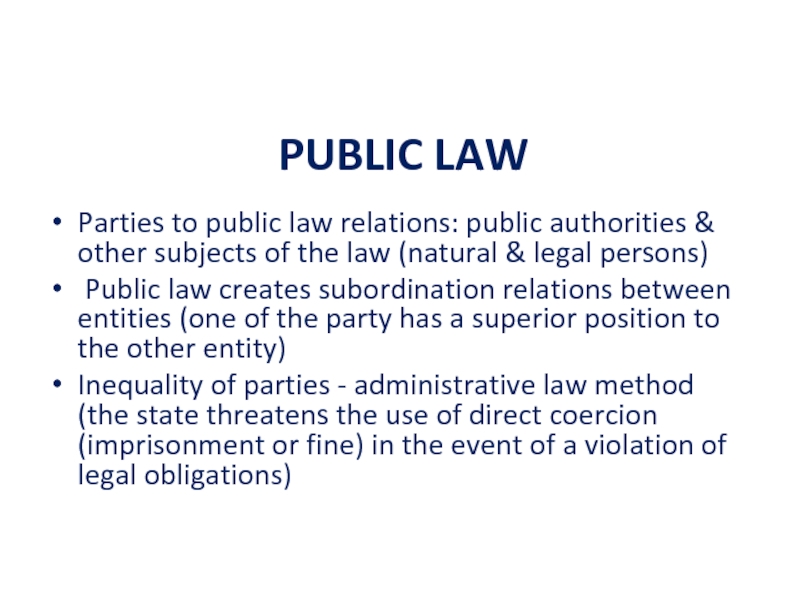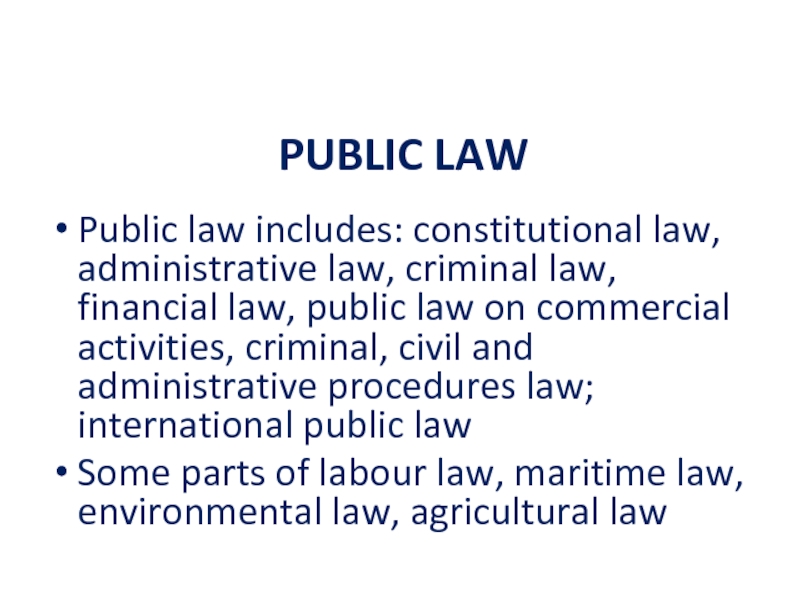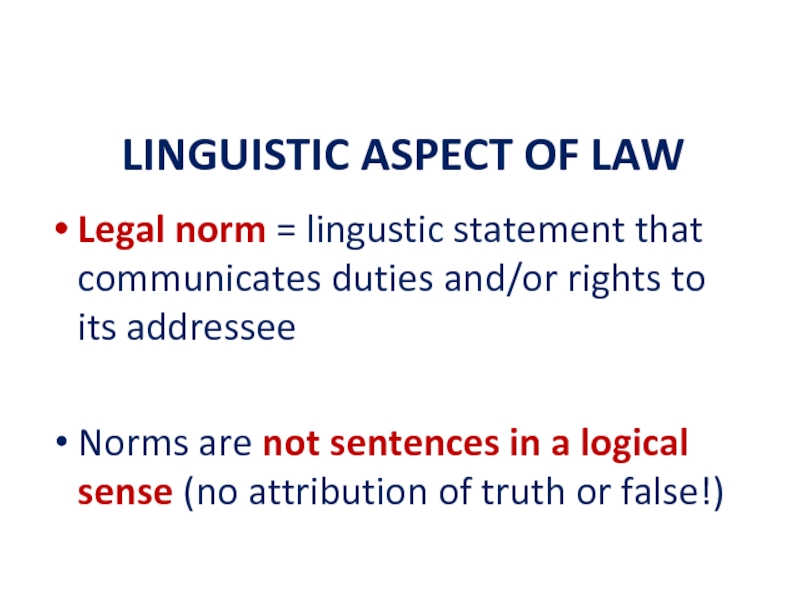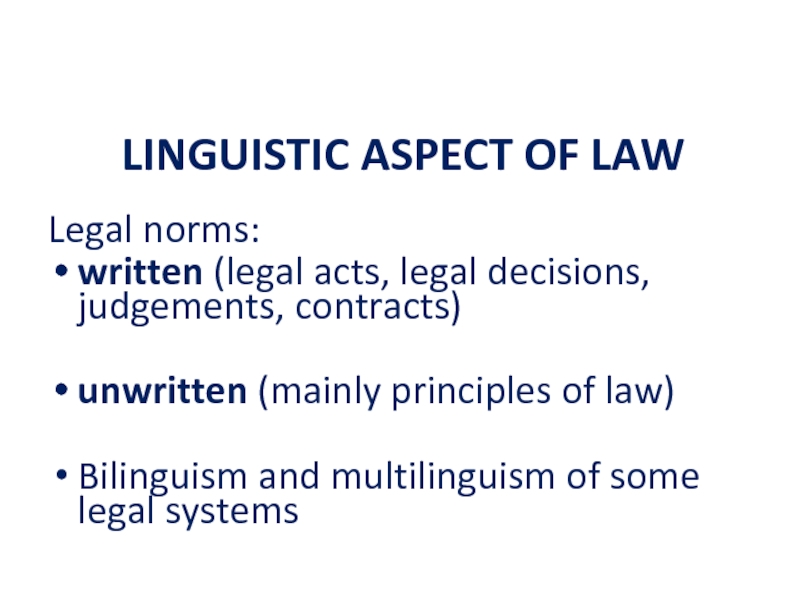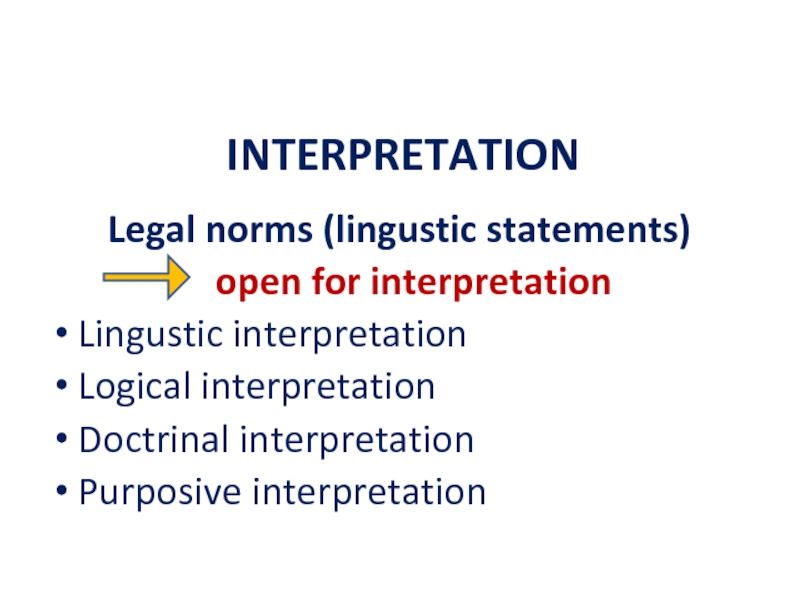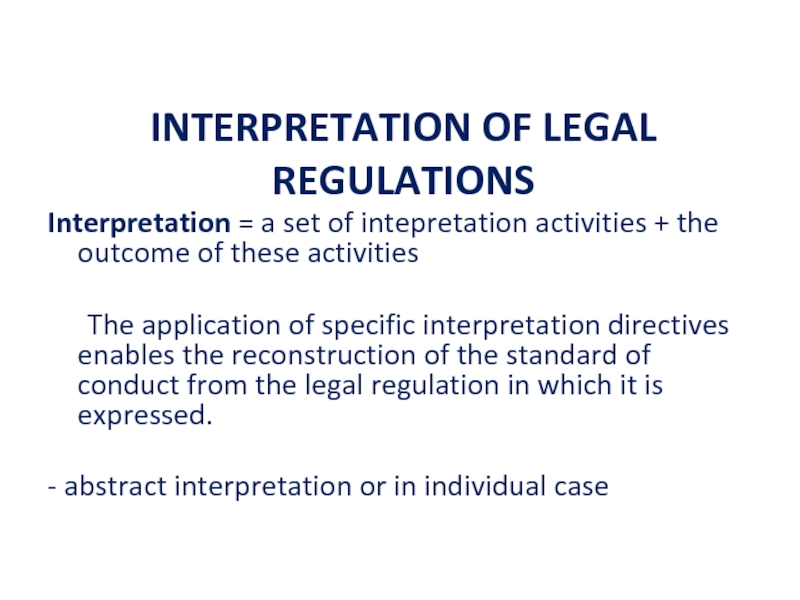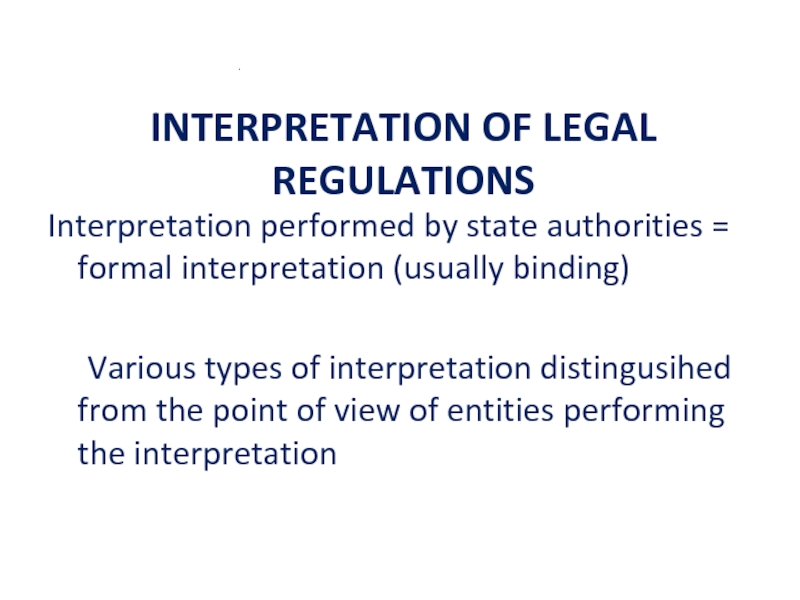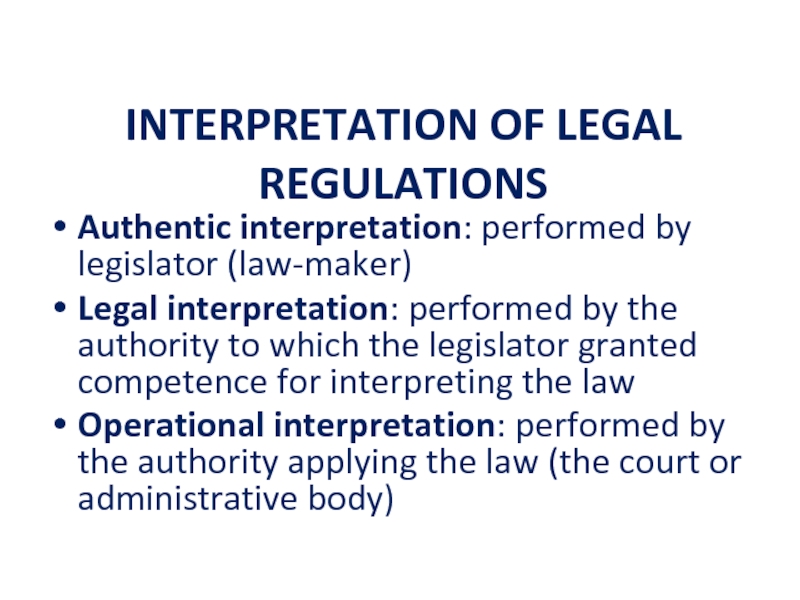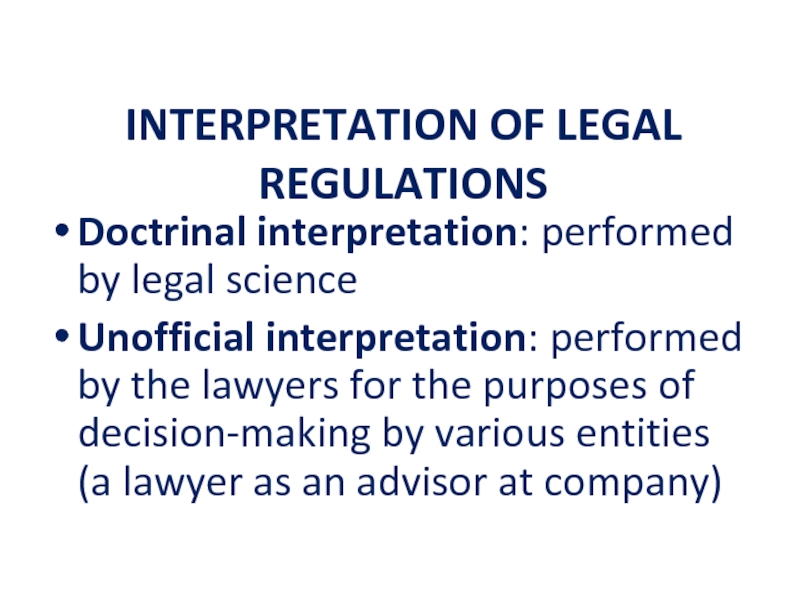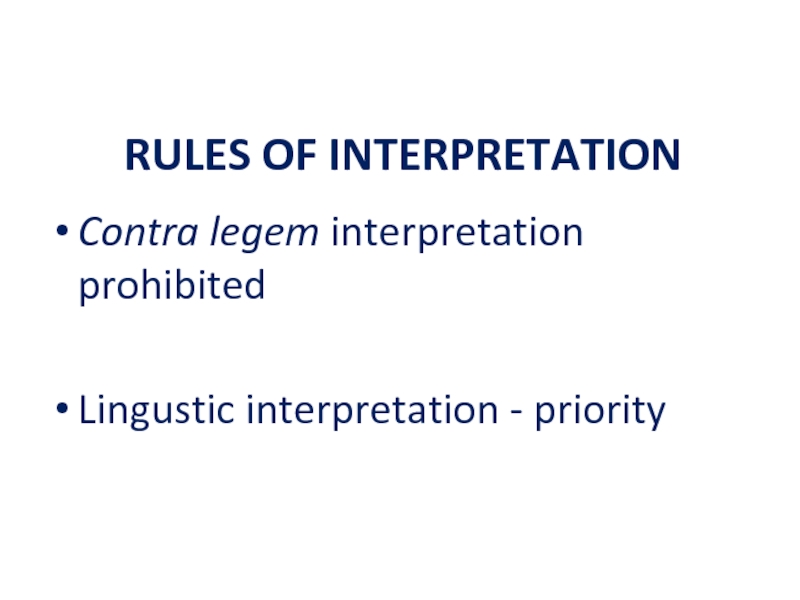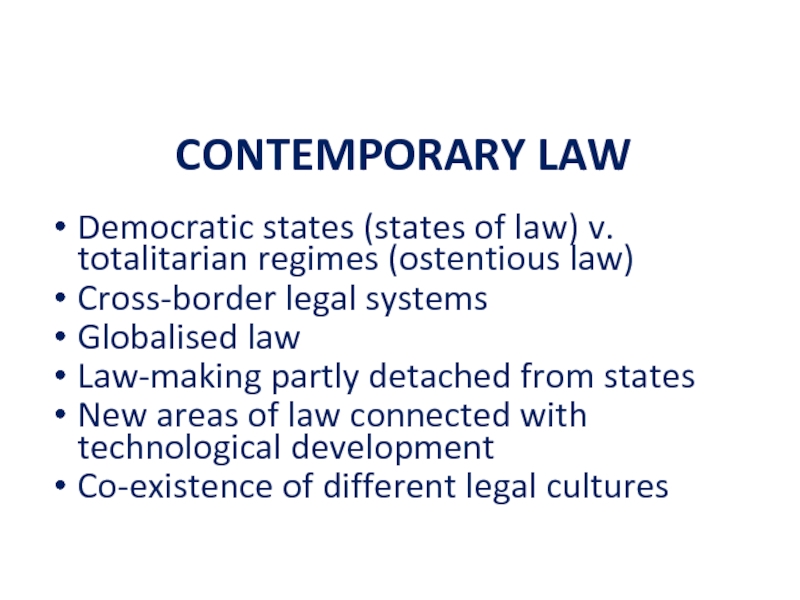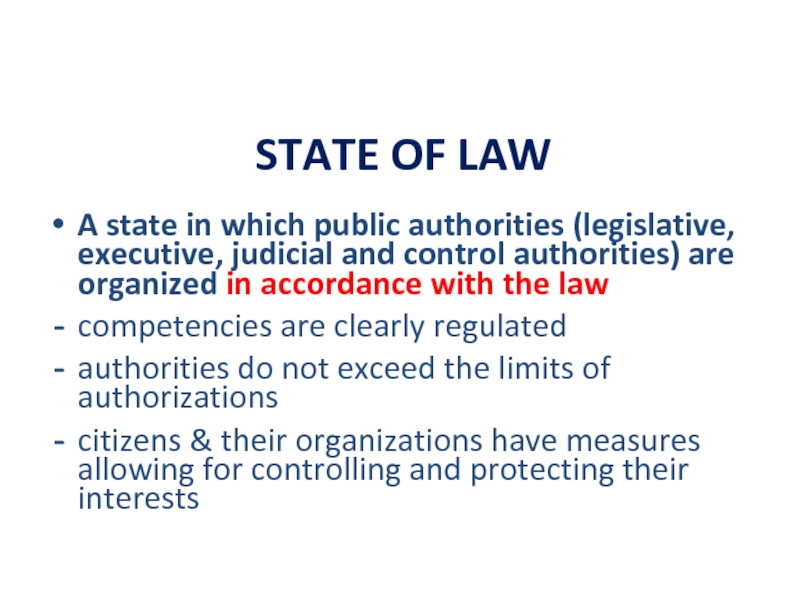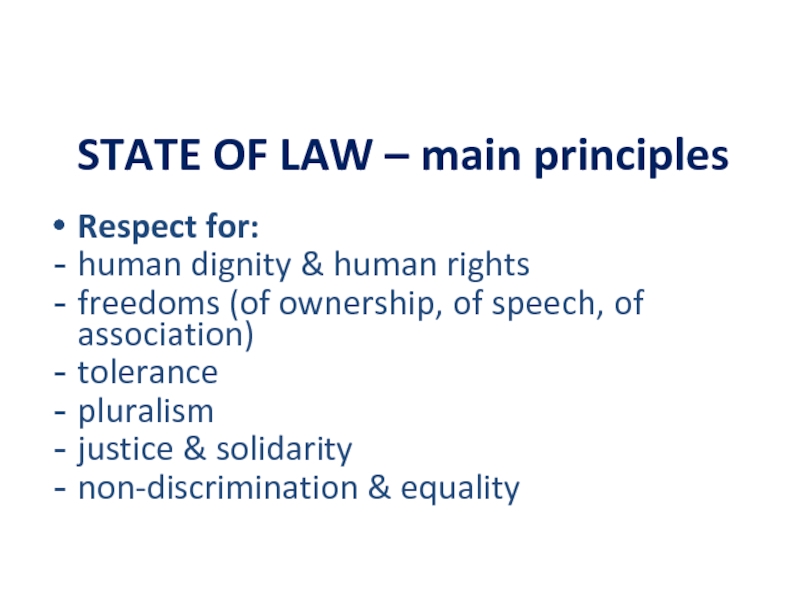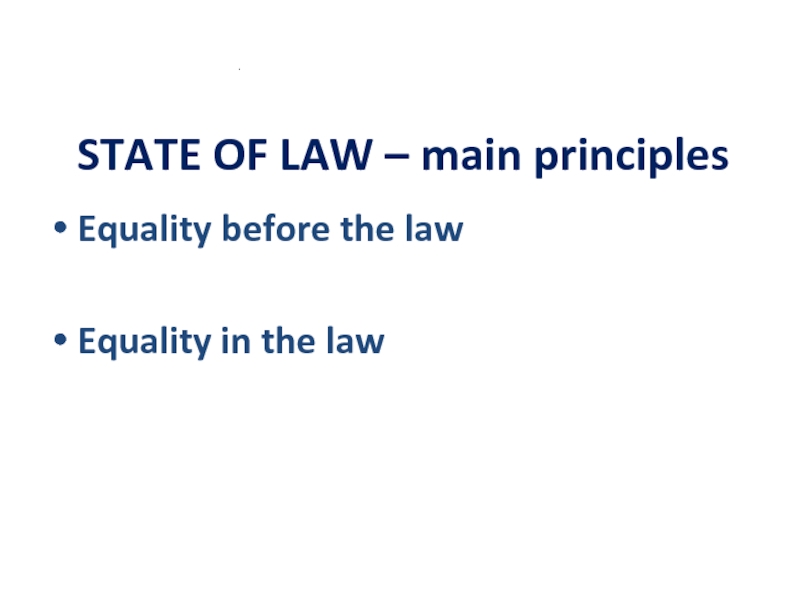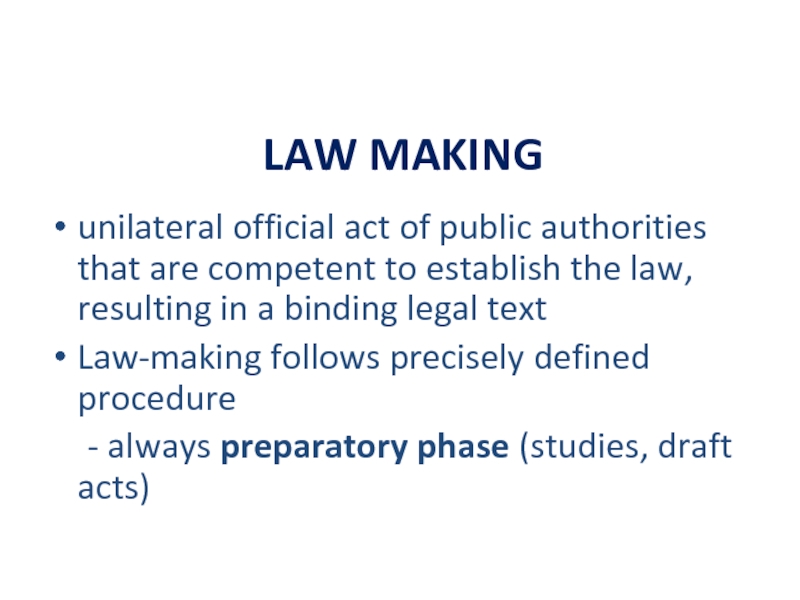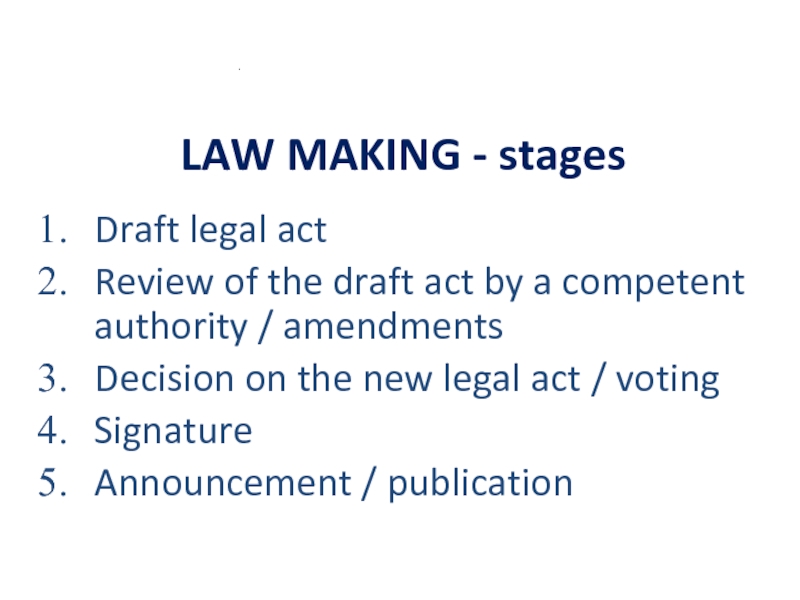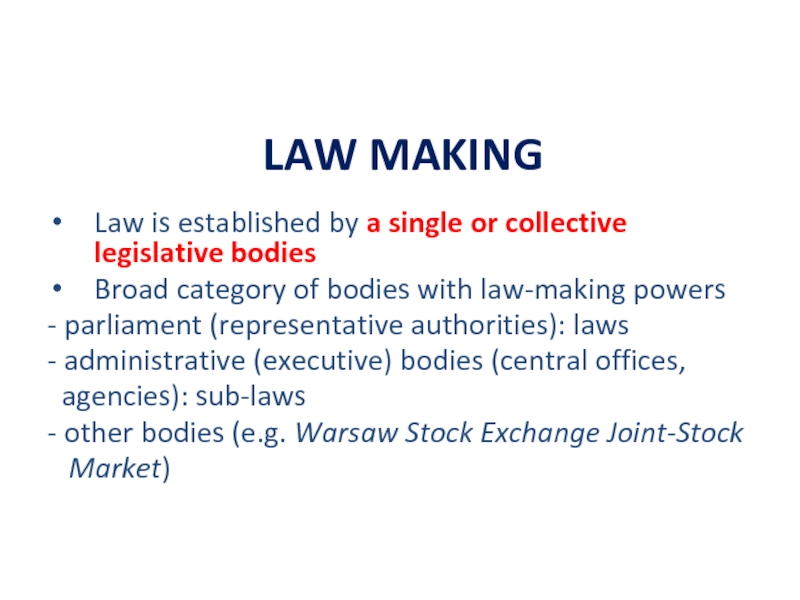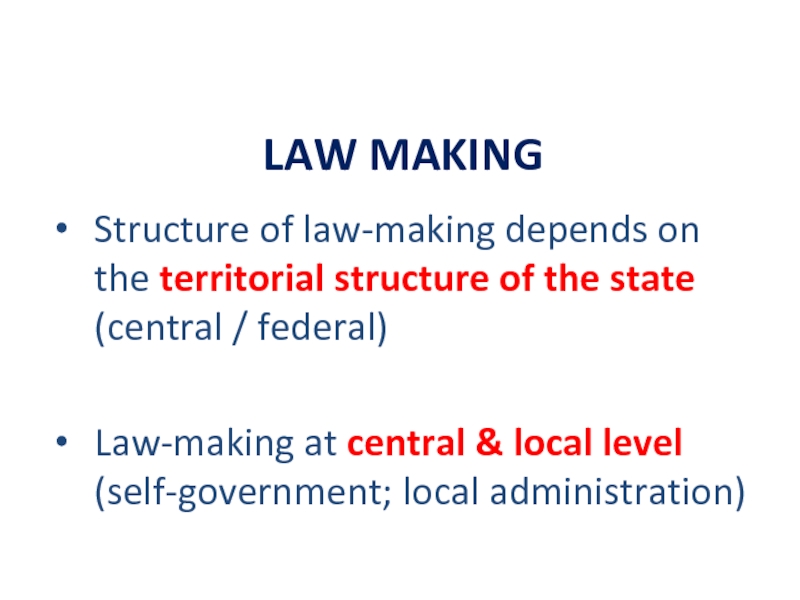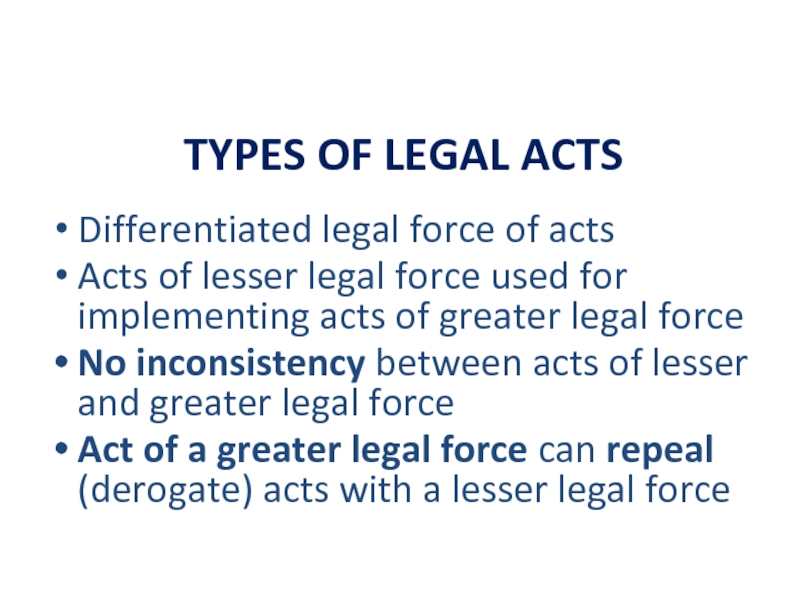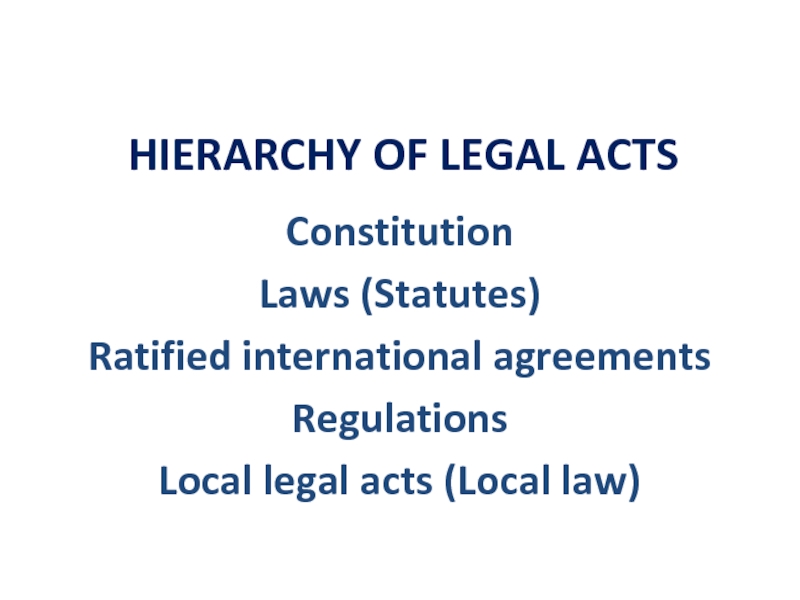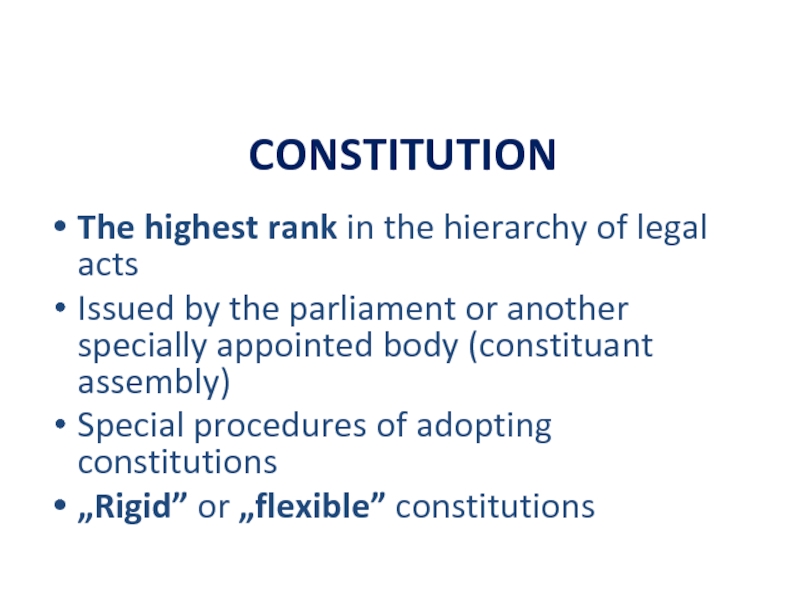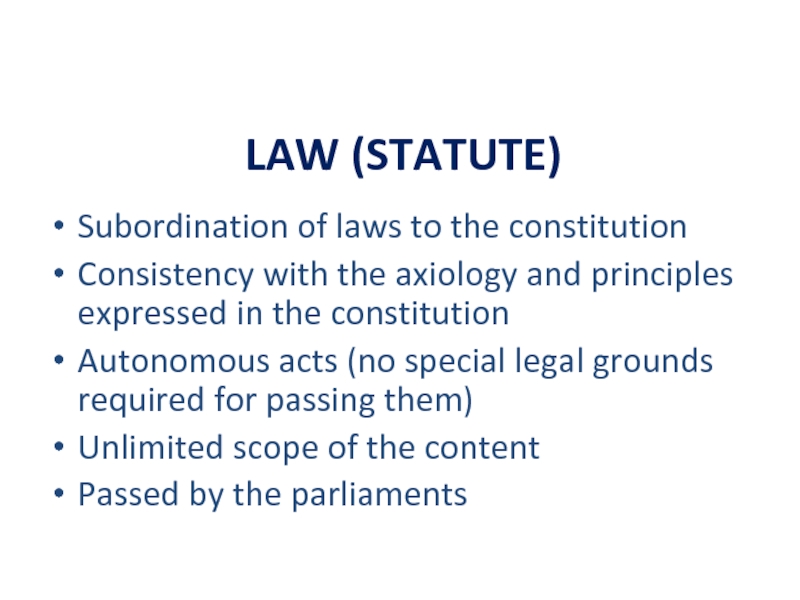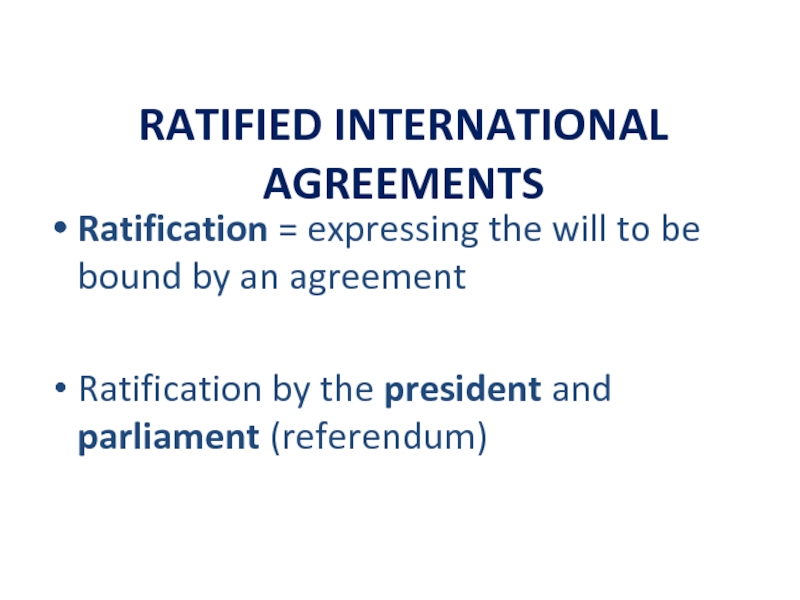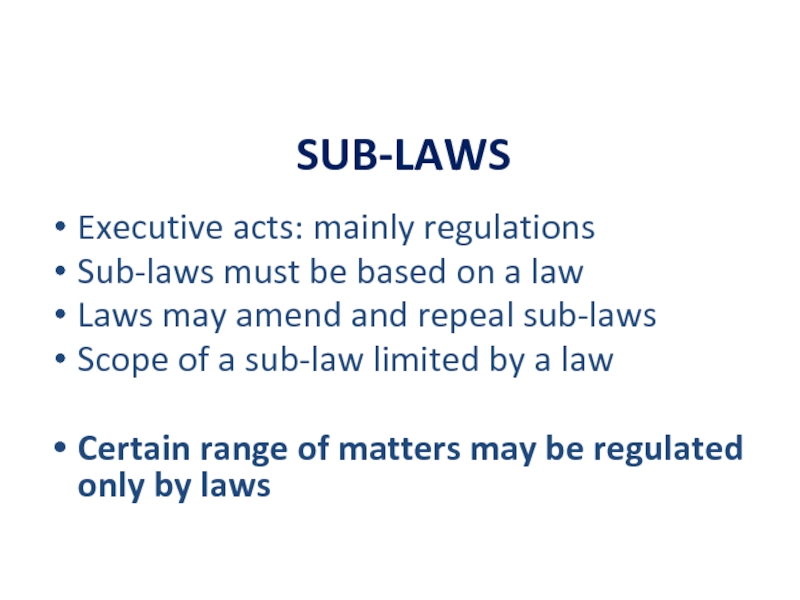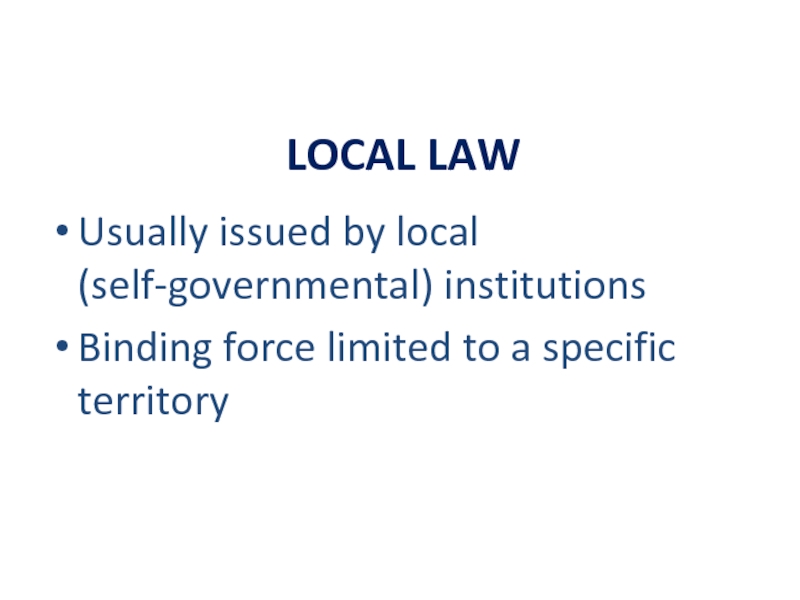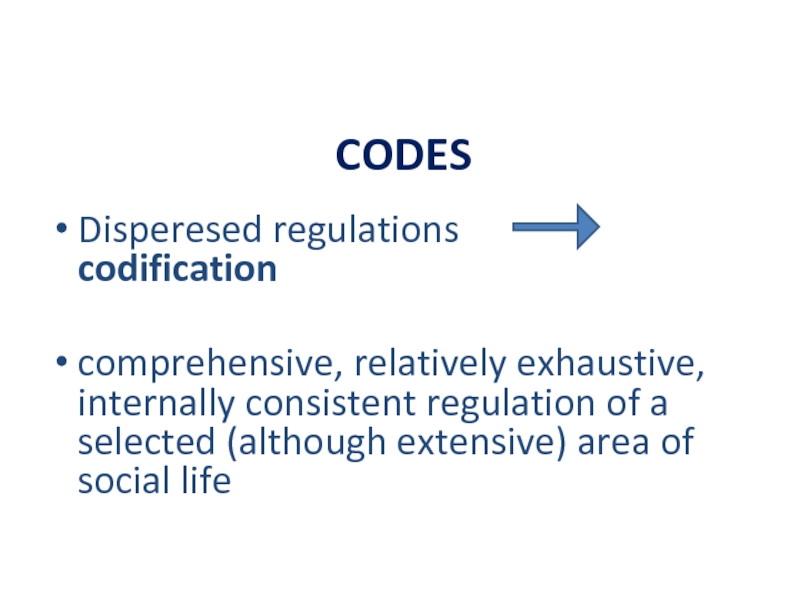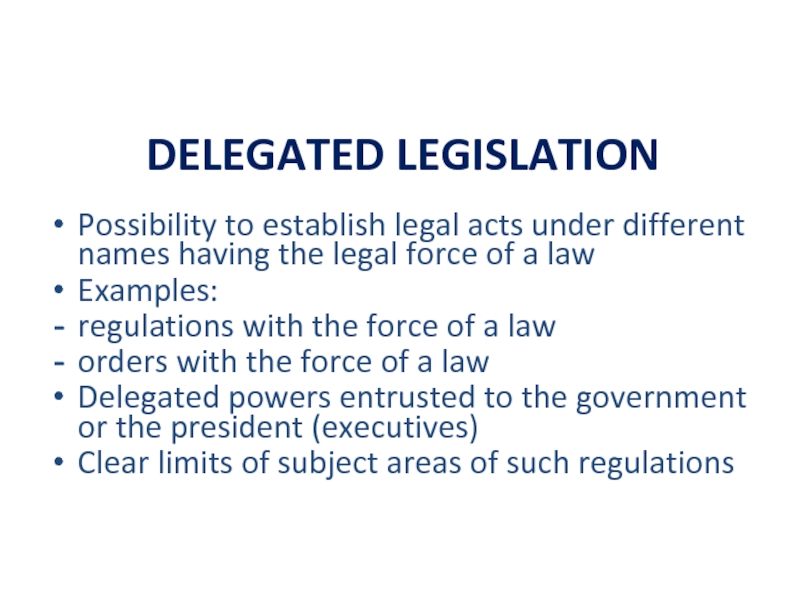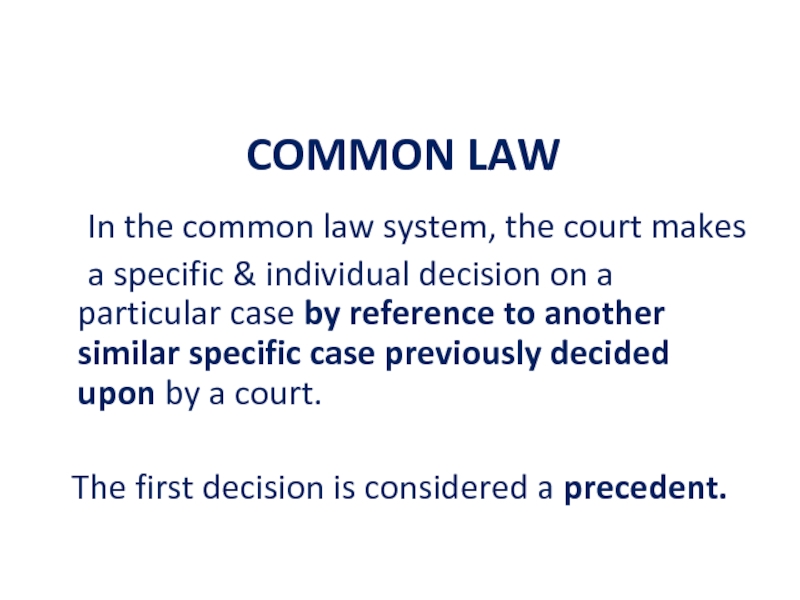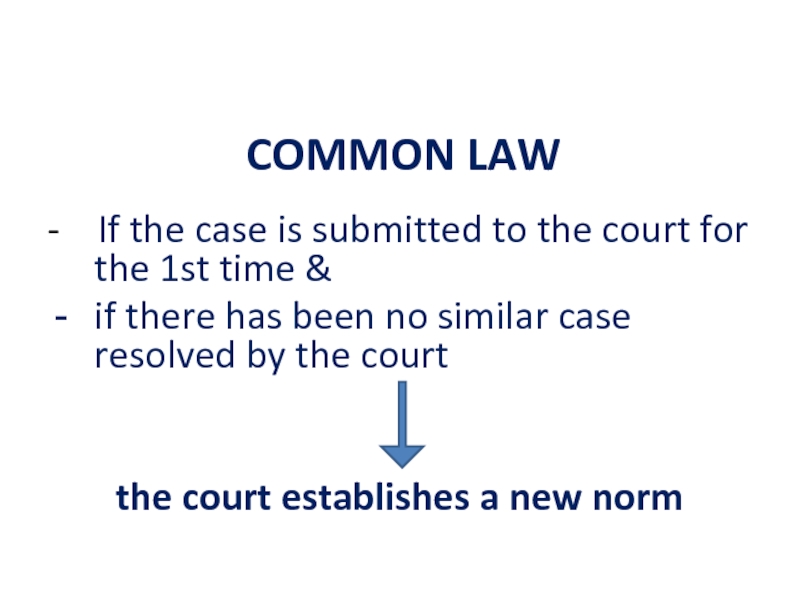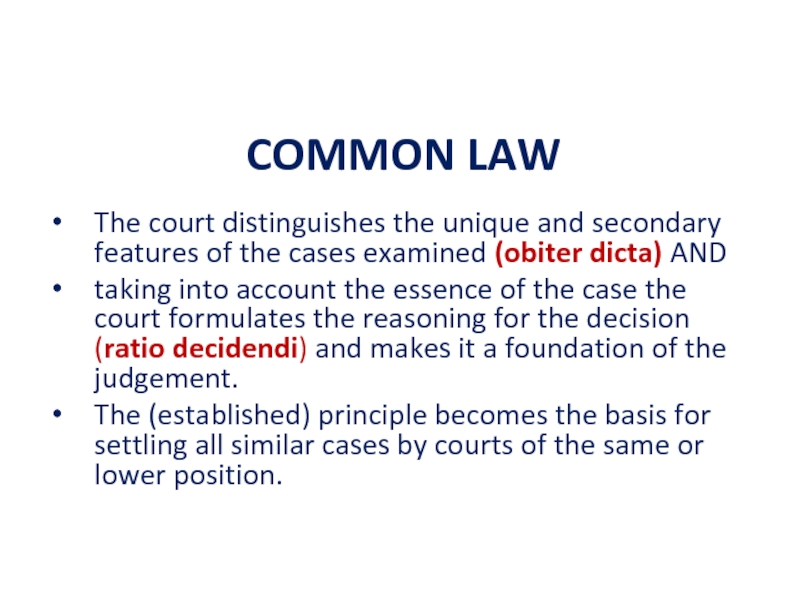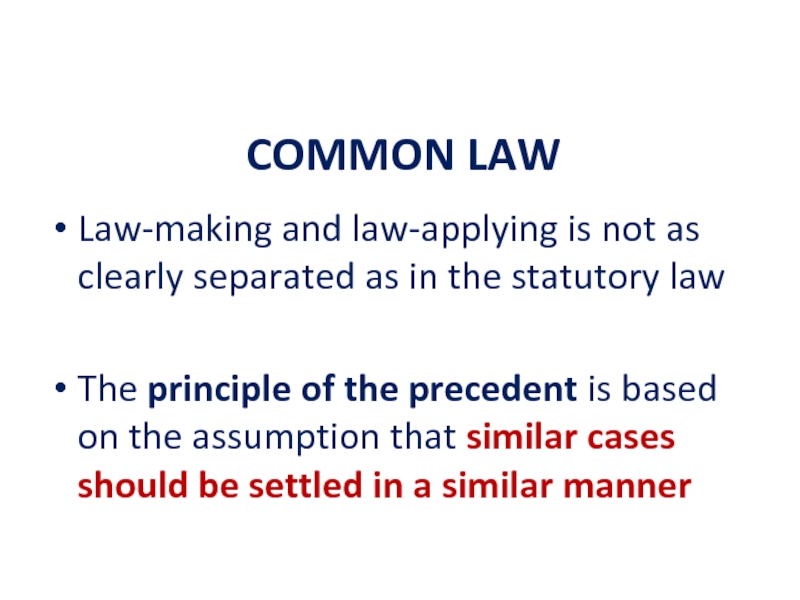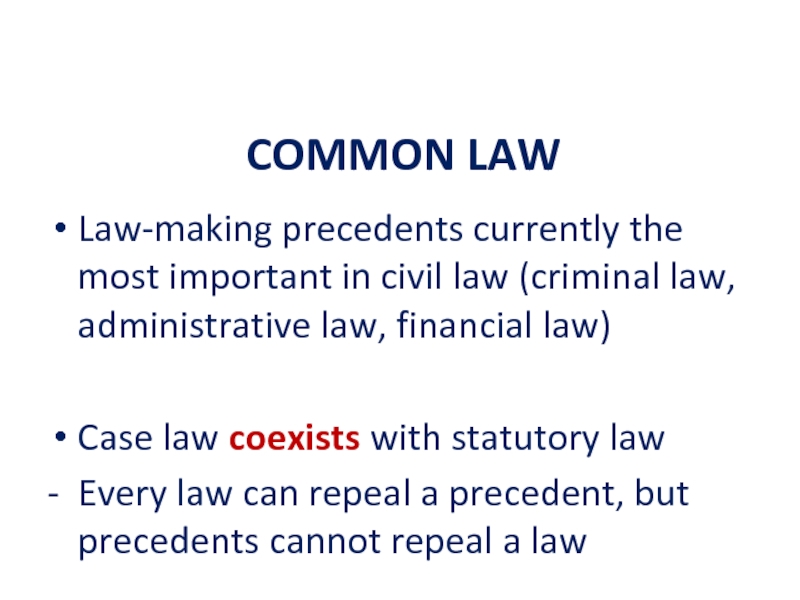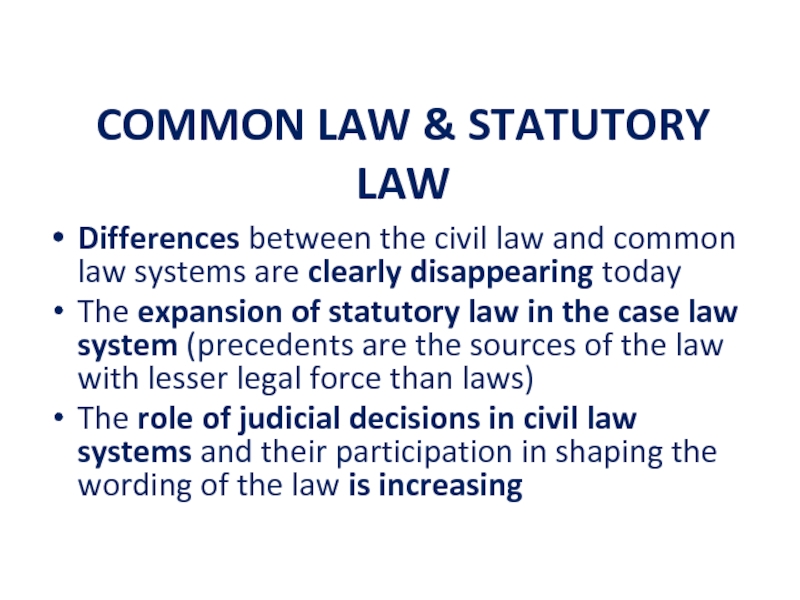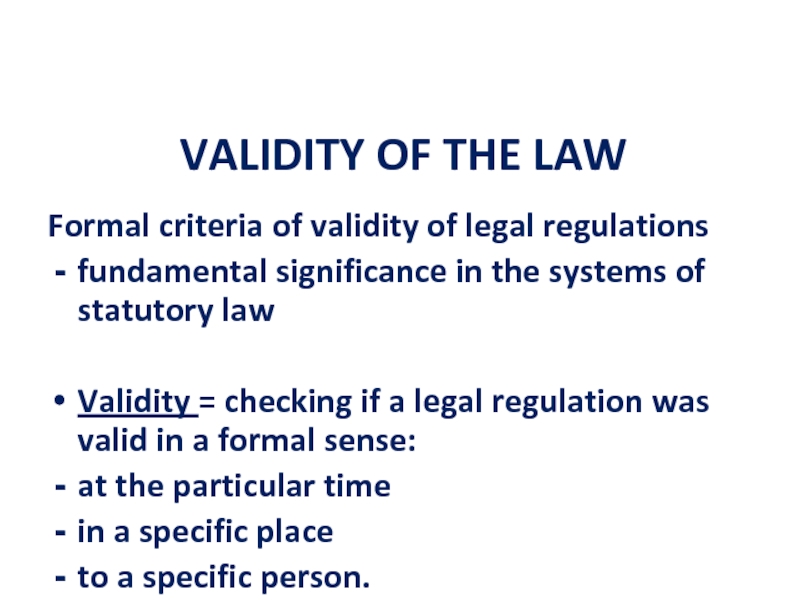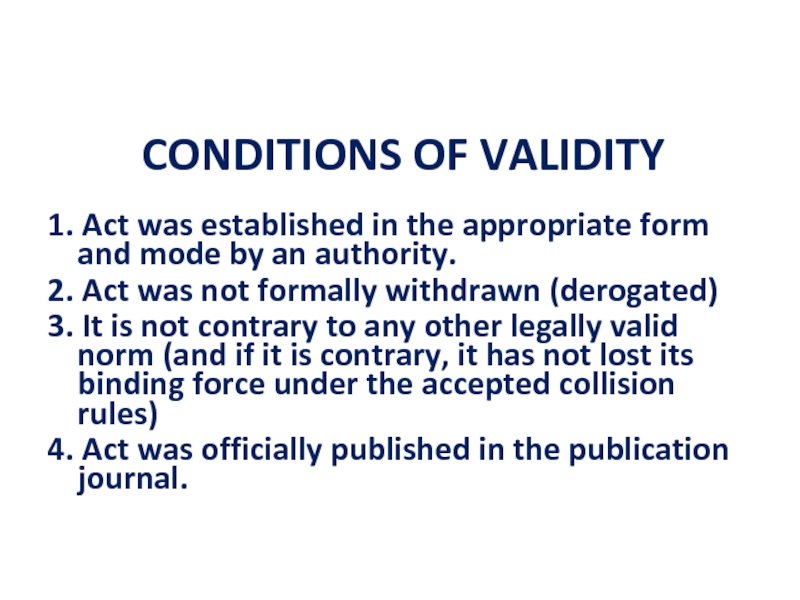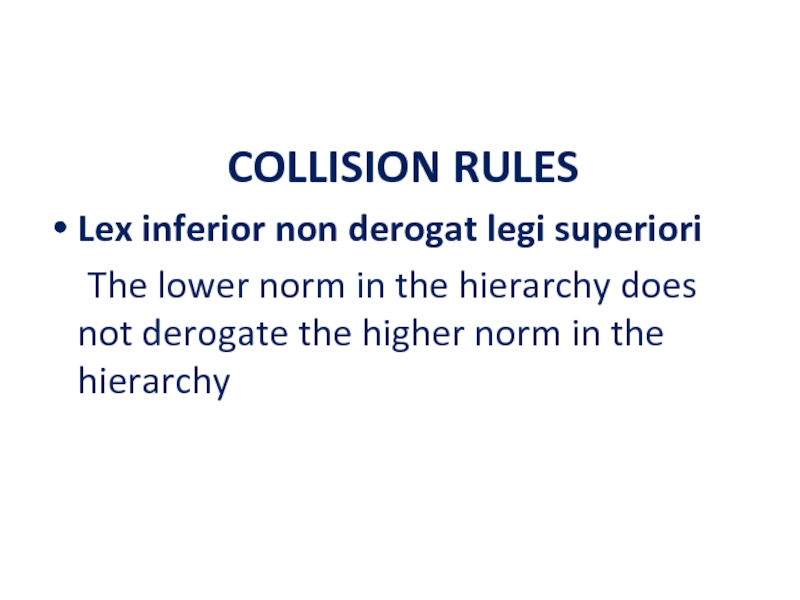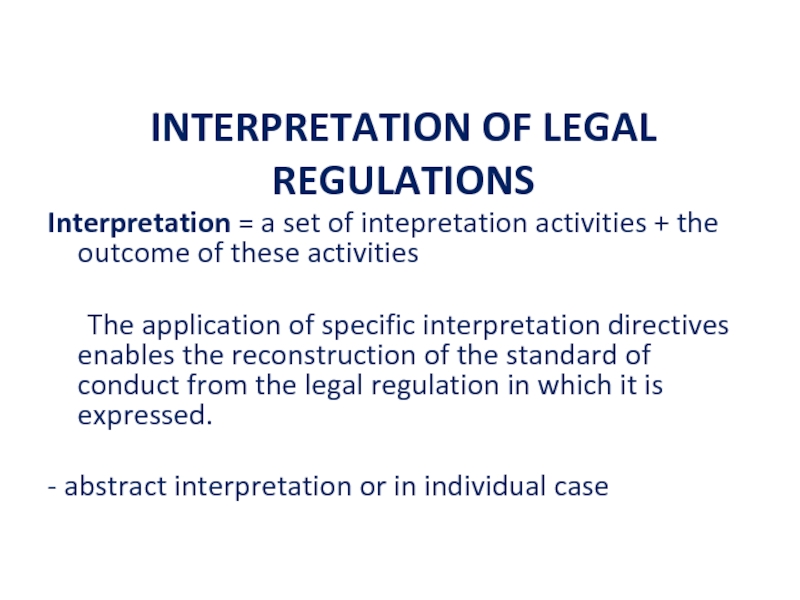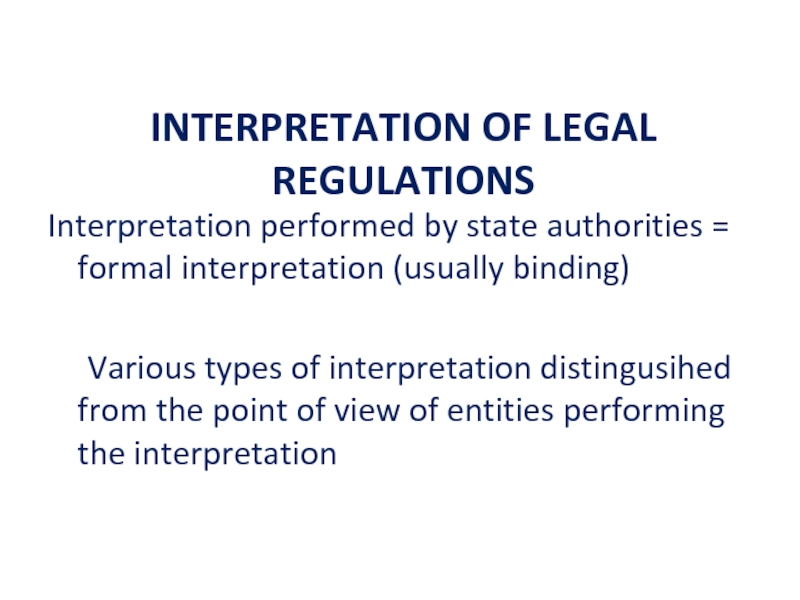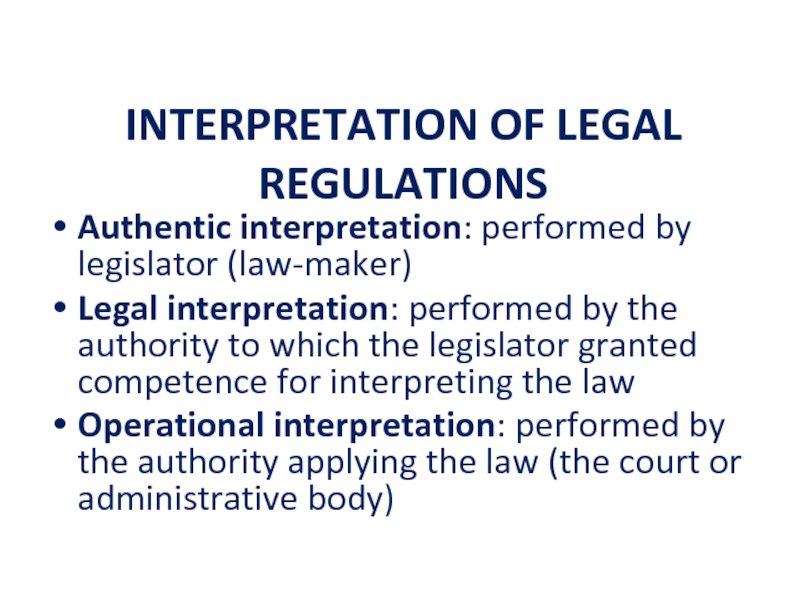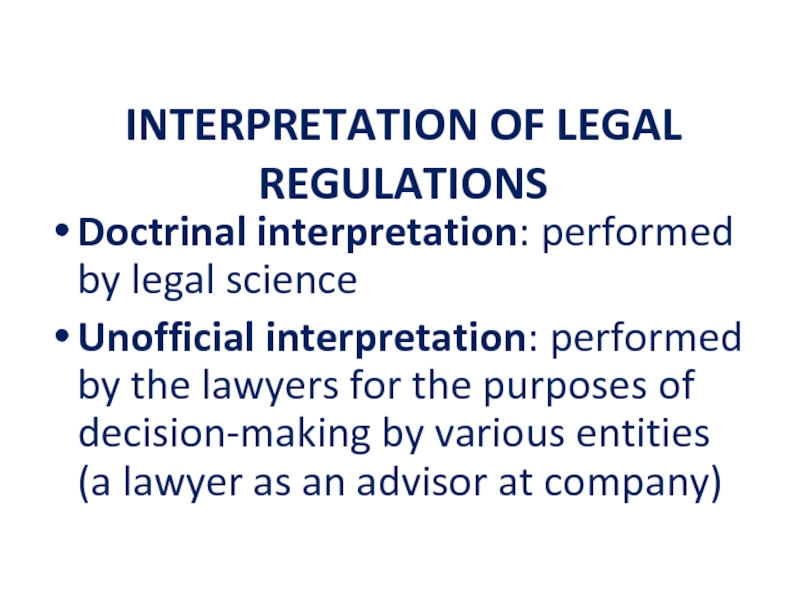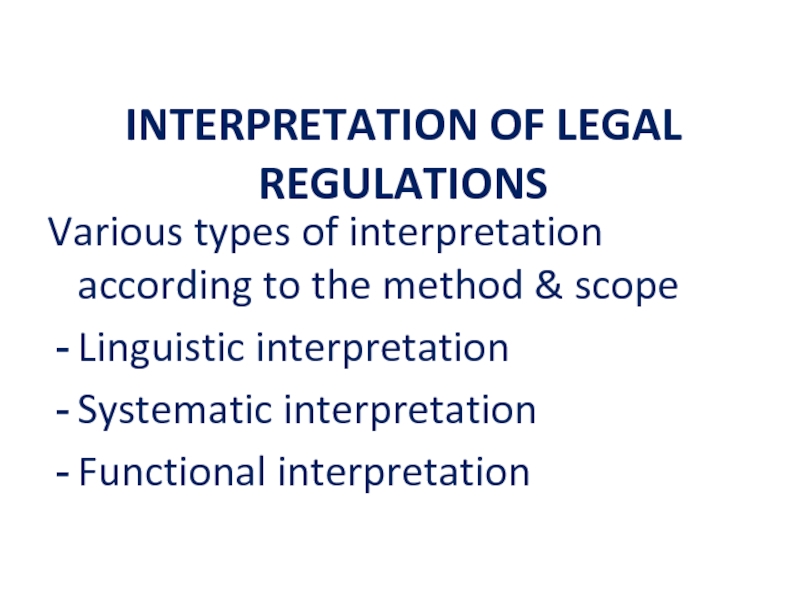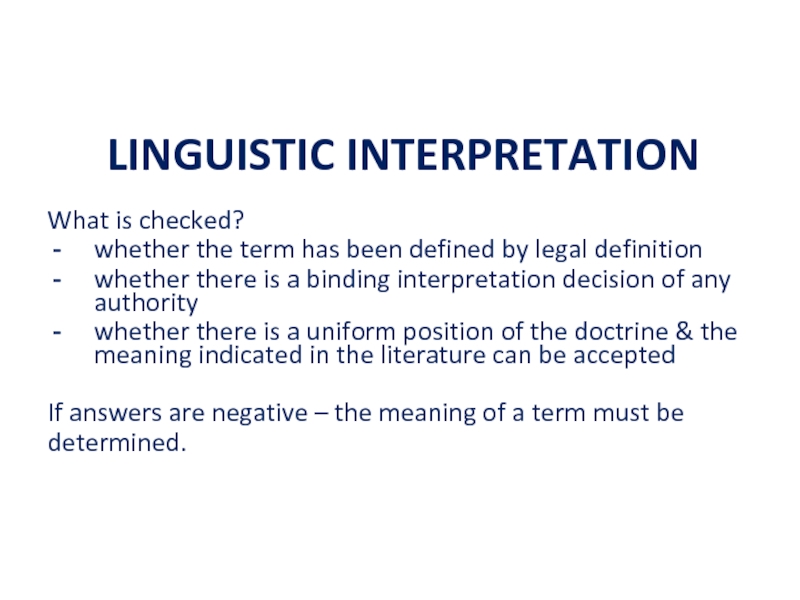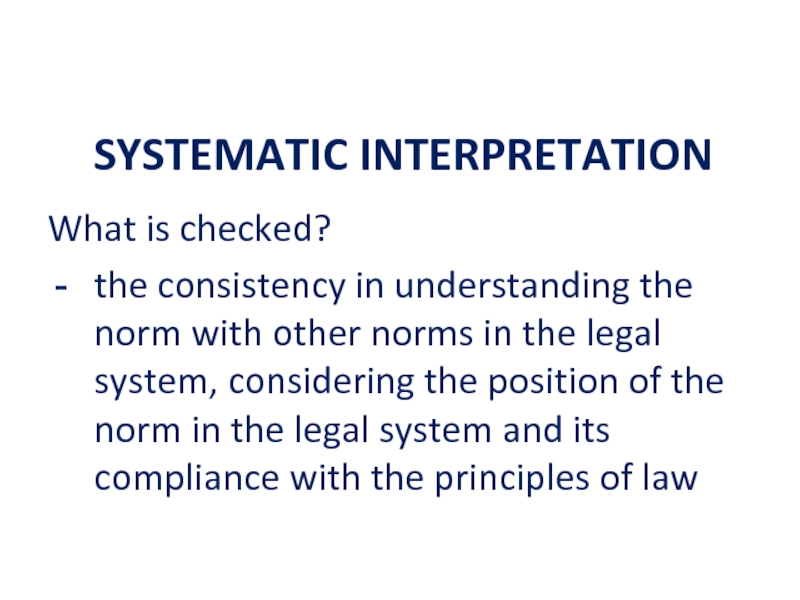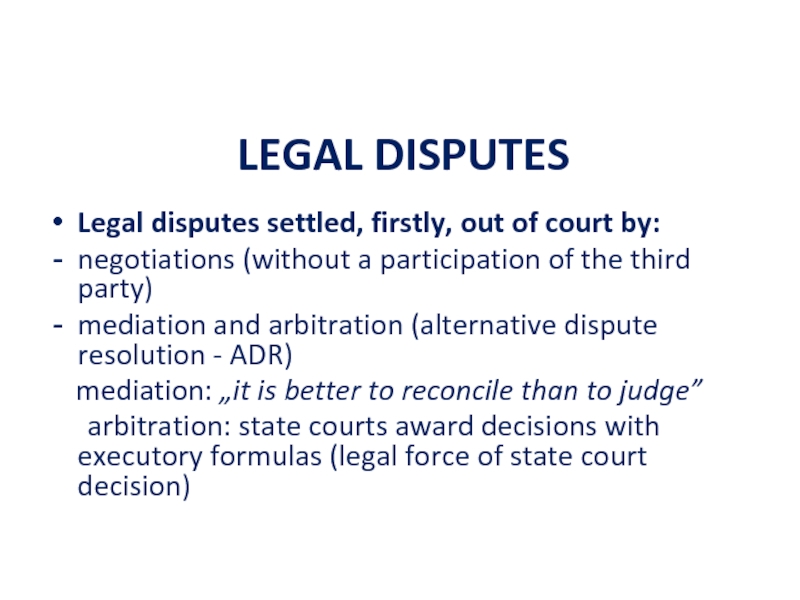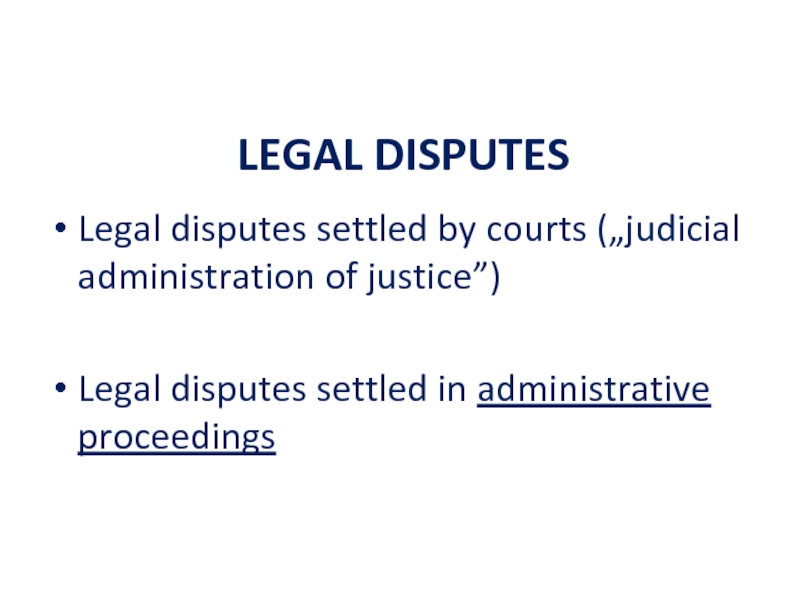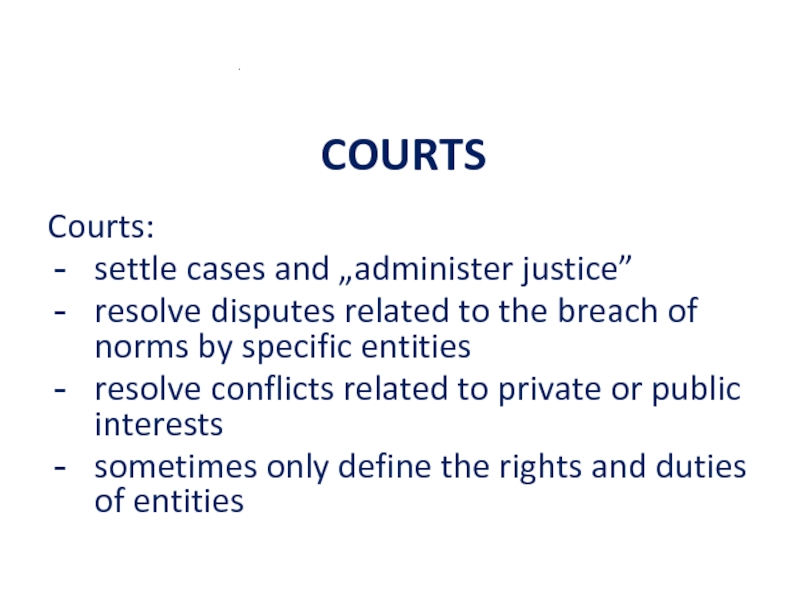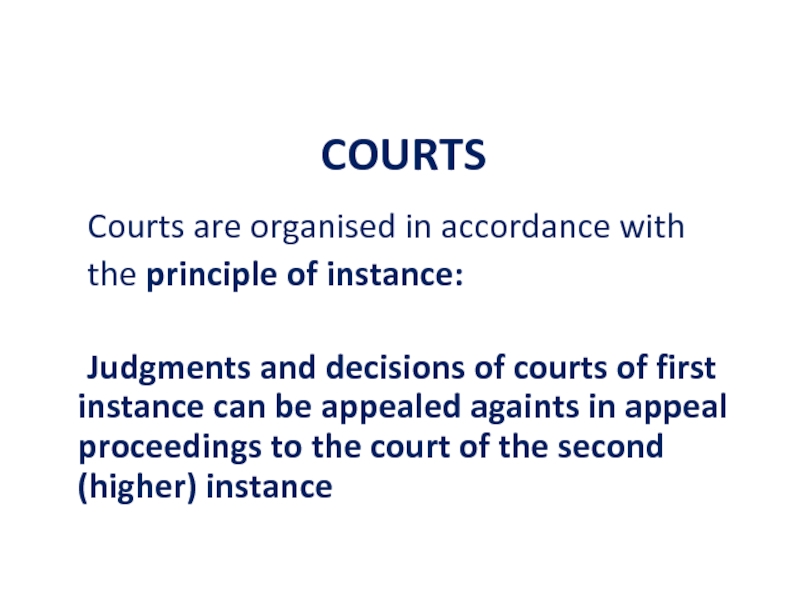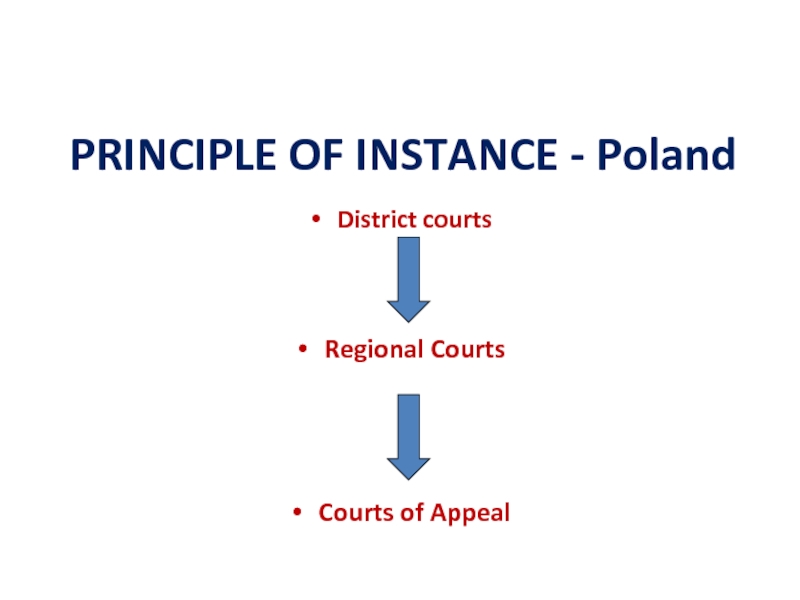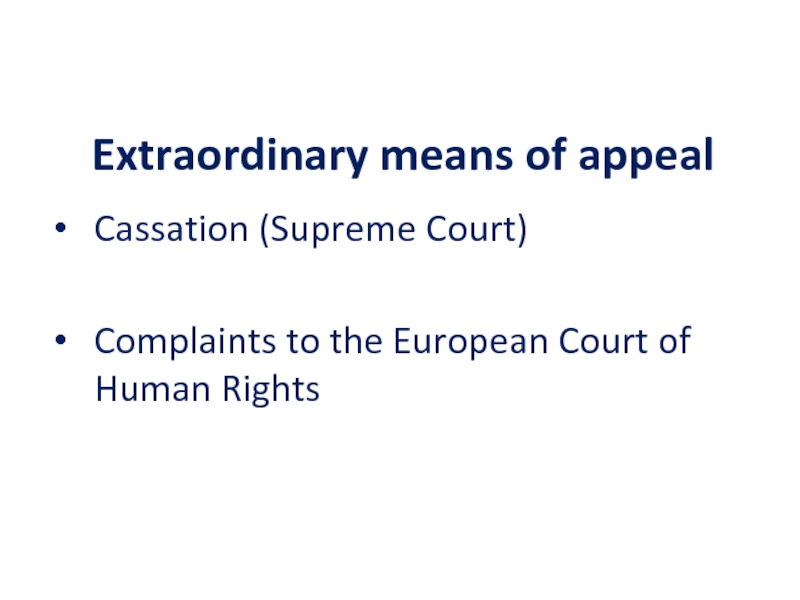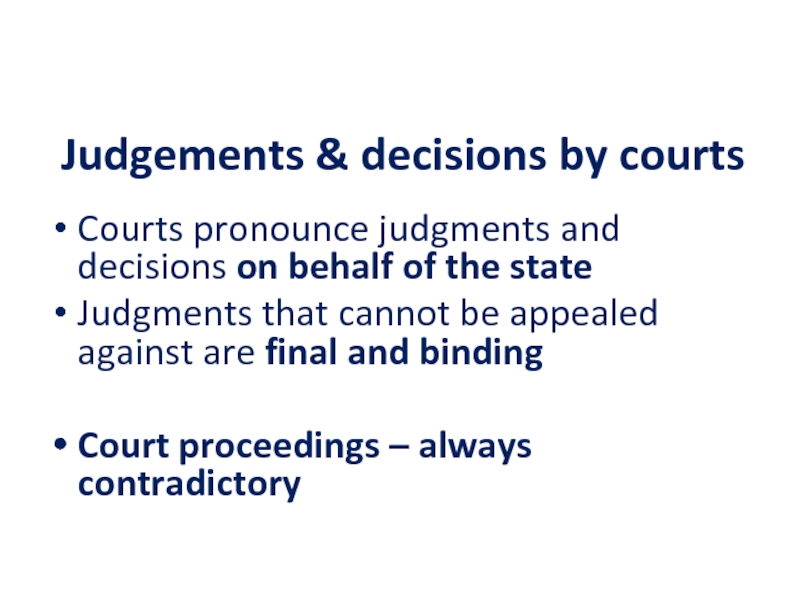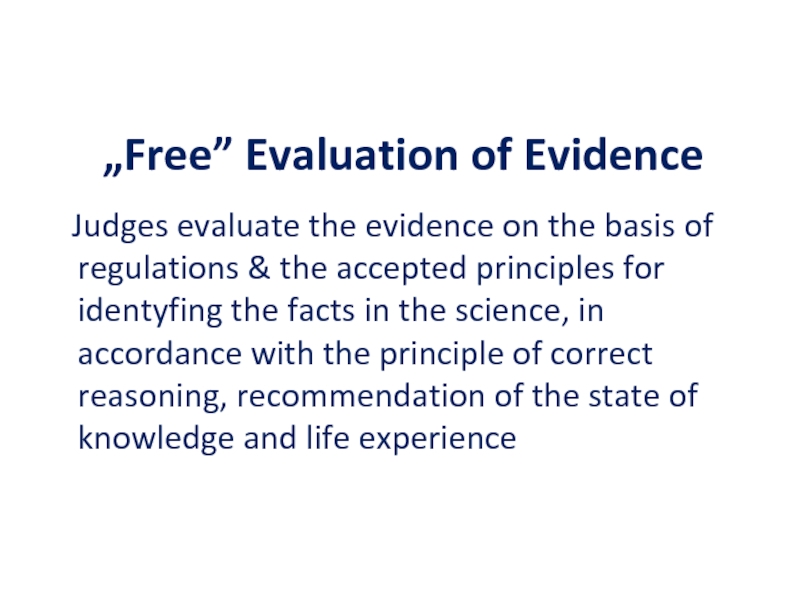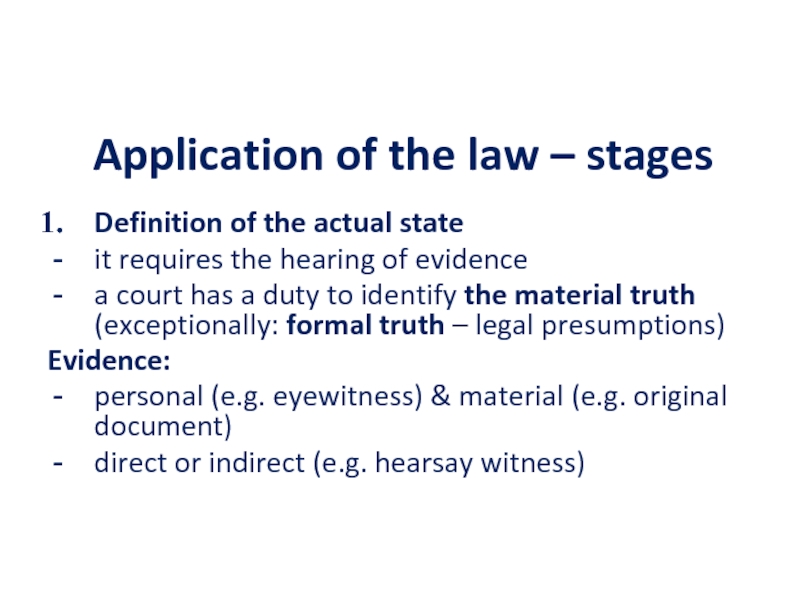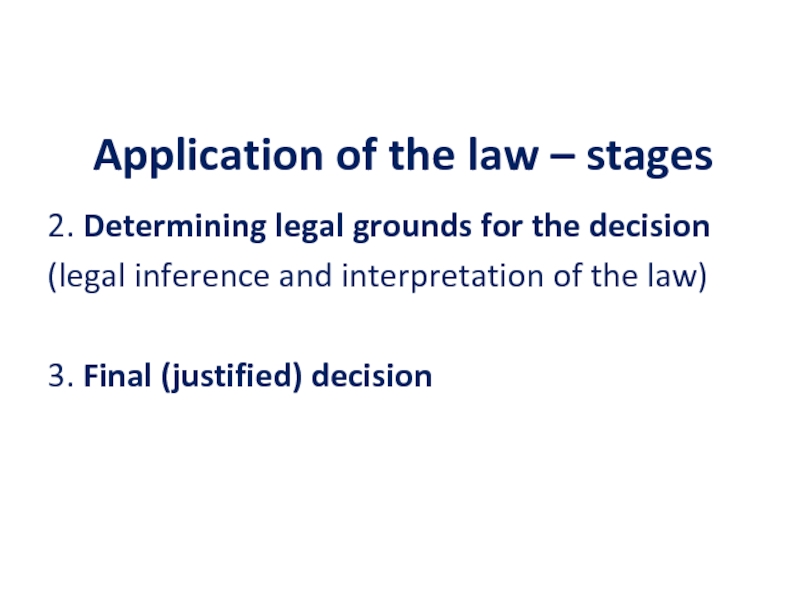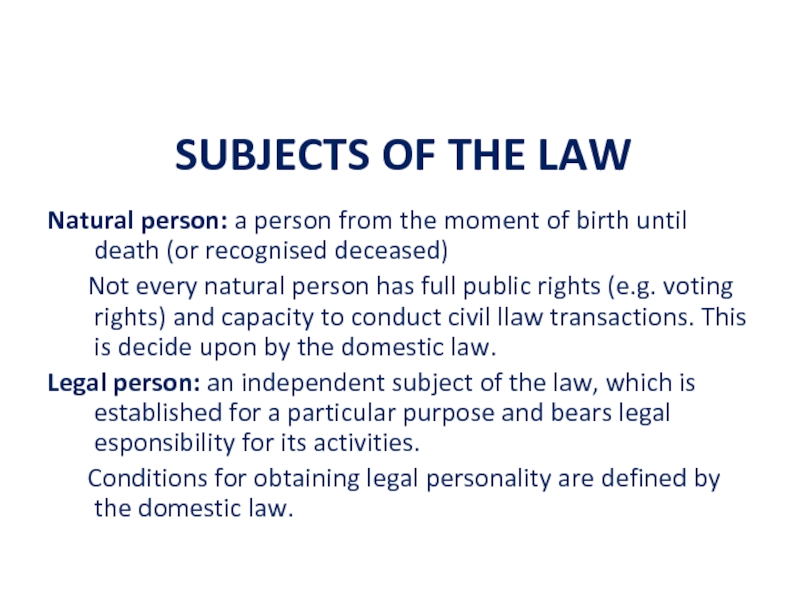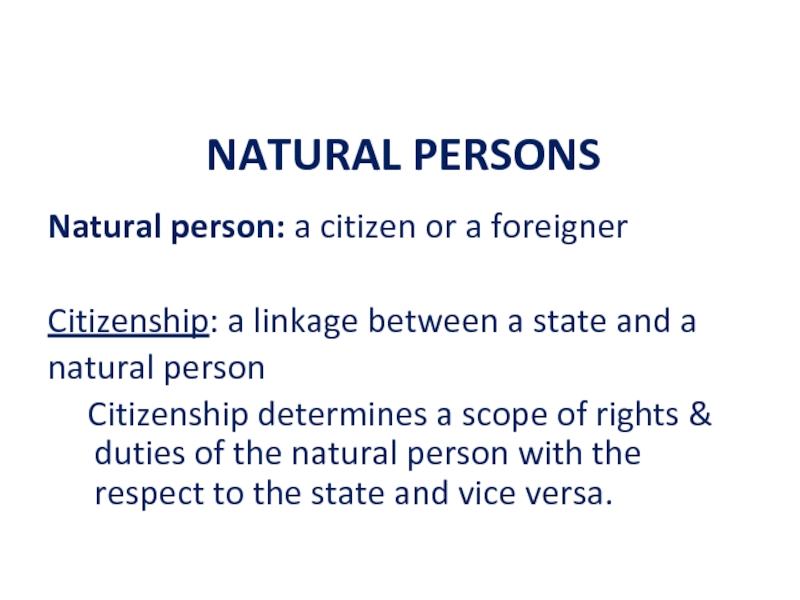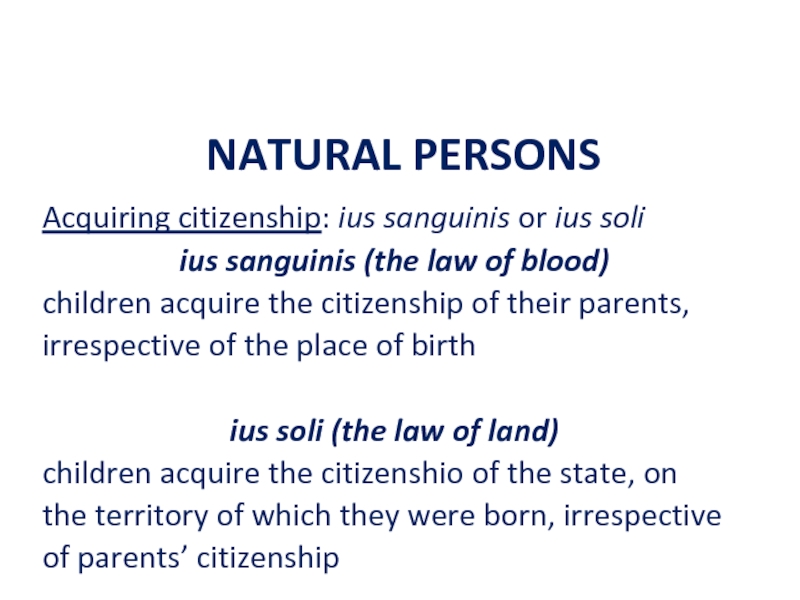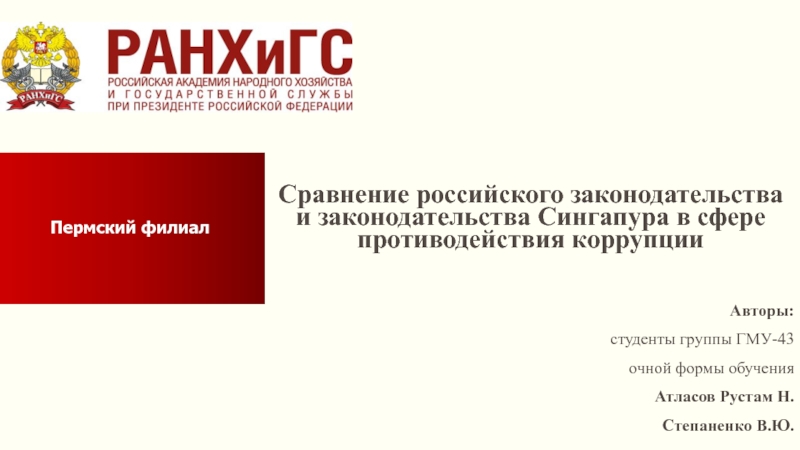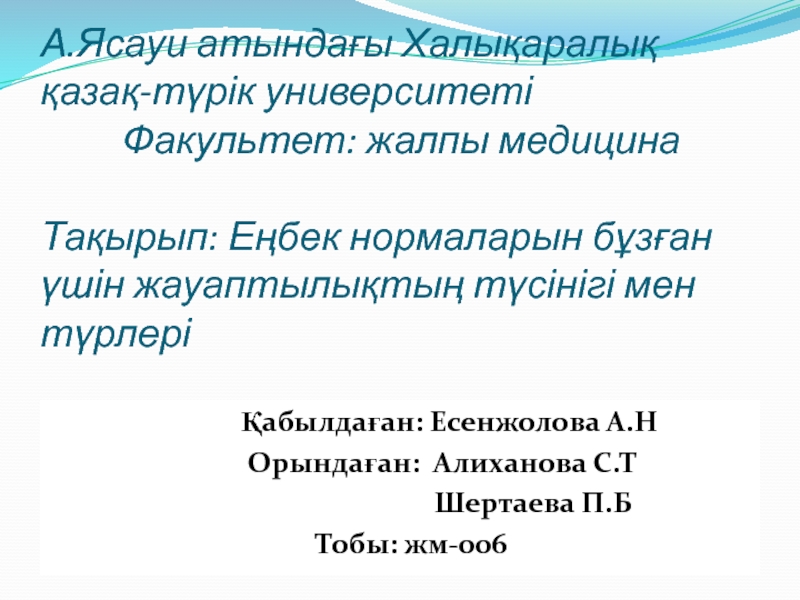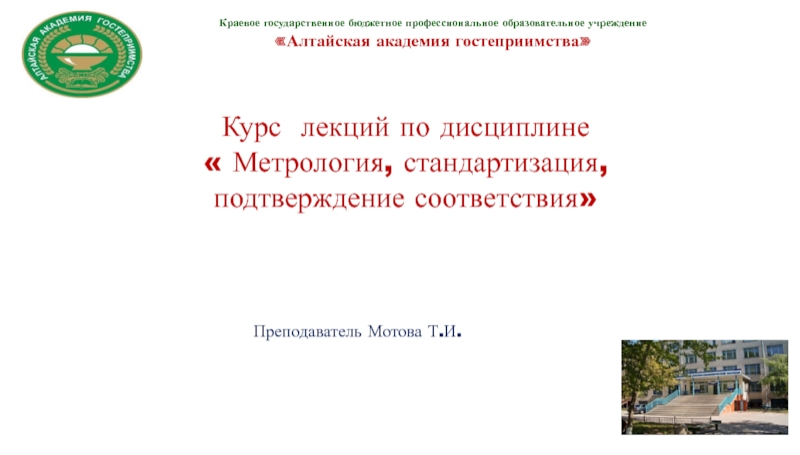- Главная
- Разное
- Дизайн
- Бизнес и предпринимательство
- Аналитика
- Образование
- Развлечения
- Красота и здоровье
- Финансы
- Государство
- Путешествия
- Спорт
- Недвижимость
- Армия
- Графика
- Культурология
- Еда и кулинария
- Лингвистика
- Английский язык
- Астрономия
- Алгебра
- Биология
- География
- Детские презентации
- Информатика
- История
- Литература
- Маркетинг
- Математика
- Медицина
- Менеджмент
- Музыка
- МХК
- Немецкий язык
- ОБЖ
- Обществознание
- Окружающий мир
- Педагогика
- Русский язык
- Технология
- Физика
- Философия
- Химия
- Шаблоны, картинки для презентаций
- Экология
- Экономика
- Юриспруденция
Functions of law презентация
Содержание
- 1. Functions of law
- 2. FUNCTIONS OF LAW Law – what is
- 3. FUNCTIONS OF LAW Norm of conduct =
- 4. FUNCTIONS OF LAW Norm of law (legal
- 5. FUNCTIONS OF LAW Law allows for the
- 6. LAW AND OTHER NORMS What determines a
- 7. LAW AND MORAL NORMS Law comes out
- 8. PROPERTIES OF LAW Law itself defines formal
- 9. PROPERTIES OF LAW Durability Stability (continuos
- 10. CONTENT OF LAW / changes Law is
- 11. OBJECTIVES OF LAW Law should: define
- 12. JUSTICE Law must be JUST Compensatory justice:
- 13. PRINCIPLES OF LAW Norms of high significance
- 14. LEGAL NORM Statement containing the directive of
- 15. LEGAL NORM ADDRESSEE (who?) CIRCUMSTANCES (when &
- 16. LEGAL NORM - example § 108. [German
- 17. LEGAL NORM - example The minor may
- 18. LEGAL PROVISION Sentence in the gramatical sense,
- 19. LEGAL PROVISION General provisions (at the begining
- 20. REFERANCE LEGAL PROVISION § 173. [German civil
- 21. LEGAL DEFINITIONS Article 4. [Polish competition act]
- 22. ANNOUNCING THE LAW Publication of legal acts
- 23. DEROGATIONS & AMENDMENTS Derogation: repealing the whole
- 24. LEGAL RELATIONSHIPS AND FACTS Legal relationships: all
- 25. LEGAL INSTITUTIONS Regulations refering to a certain
- 26. IGNORANTIA IURIS NOCET „Ignorance of the
- 27. DOMESTIC (NATIONAL) LAW Internal law of a
- 28. INTERNATIONAL LAW used to impose duties on
- 29. PUBLIC LAW & PRIVATE LAW Division that
- 30. PRIVATE LAW All the principles that regulate
- 31. PRIVATE LAW Iuris dispositivi (relatively valid regulations)
- 32. PRIVATE LAW Civil substantive law (including commercial
- 33. PUBLIC LAW Public law regulates the system
- 34. PUBLIC LAW Parties to public law relations:
- 35. PUBLIC LAW Public law includes: constitutional law,
- 36. LINGUISTIC ASPECT OF LAW Legal norm
- 37. LINGUISTIC ASPECT OF LAW Legal norms:
- 38. INTERPRETATION Legal norms (lingustic statements)
- 39. INTERPRETATION OF LEGAL REGULATIONS Interpretation = a
- 40. INTERPRETATION OF LEGAL REGULATIONS Interpretation performed by
- 41. INTERPRETATION OF LEGAL REGULATIONS Authentic interpretation: performed
- 42. INTERPRETATION OF LEGAL REGULATIONS Doctrinal interpretation: performed
- 43. RULES OF INTERPRETATION Contra legem interpretation
- 44. CONTEMPORARY LAW Democratic states (states of
- 45. STATE OF LAW A state in which
- 46. STATE OF LAW – main principles Respect
- 47. STATE OF LAW – main principles Equality
- 48. LAW MAKING unilateral official act of public
- 49. LAW MAKING - stages Draft legal act
- 50. LAW MAKING Law is established by a
- 51. LAW MAKING Structure of law-making depends on
- 52. TYPES OF LEGAL ACTS Differentiated legal force
- 53. HIERARCHY OF LEGAL ACTS Constitution Laws (Statutes)
- 54. CONSTITUTION The highest rank in the
- 55. LAW (STATUTE) Subordination of laws to
- 56. RATIFIED INTERNATIONAL AGREEMENTS Ratification = expressing the
- 57. SUB-LAWS Executive acts: mainly regulations Sub-laws
- 58. LOCAL LAW Usually issued by local (self-governmental)
- 59. CODES Disperesed regulations
- 60. DELEGATED LEGISLATION Possibility to establish legal acts
- 61. COMMON LAW In the common law
- 62. COMMON LAW - If the case
- 63. COMMON LAW The court distinguishes the unique
- 64. COMMON LAW Law-making and law-applying is not
- 65. COMMON LAW Law-making precedents currently the most
- 66. COMMON LAW & STATUTORY LAW Differences between
- 67. VALIDITY OF THE LAW Formal criteria of
- 68. CONDITIONS OF VALIDITY 1. Act was established
- 69. COLLISION RULES Lex inferior non derogat legi
- 70. INTERPRETATION OF LEGAL REGULATIONS Interpretation = a
- 71. INTERPRETATION OF LEGAL REGULATIONS Interpretation performed by
- 72. INTERPRETATION OF LEGAL REGULATIONS Authentic interpretation: performed
- 73. INTERPRETATION OF LEGAL REGULATIONS Doctrinal interpretation: performed
- 74. INTERPRETATION OF LEGAL REGULATIONS Various types of
- 75. LINGUISTIC INTERPRETATION What is checked? whether the
- 76. SYSTEMATIC INTERPRETATION What is checked? the consistency
- 77. LEGAL DISPUTES Legal disputes settled, firstly, out
- 78. LEGAL DISPUTES Legal disputes settled by courts
- 79. COURTS Courts: settle cases and „administer justice”
- 80. COURTS Courts are organised in accordance with
- 81. PRINCIPLE OF INSTANCE - Poland District courts
- 82. Extraordinary means of appeal Cassation (Supreme
- 83. Judgements & decisions by courts Courts pronounce
- 84. „Free” Evaluation of Evidence Judges
- 85. Application of the law – stages Definition
- 86. Application of the law – stages 2.
- 87. SUBJECTS OF THE LAW Natural person:
- 88. NATURAL PERSONS Natural person: a citizen or
- 89. NATURAL PERSONS Acquiring citizenship: ius sanguinis or
Слайд 3FUNCTIONS OF LAW
Norm of conduct = a directive targeted at a
Norm of conduct establishes a model of behaviour
Слайд 4FUNCTIONS OF LAW
Norm of law (legal norm) v. norm of conduct
Legal norms = directives that organise, manage and control social life through the will of the public authorities (state)
Legal norms are:
created by the state
applied by the state
enforced by the authorities of the state (imperium)
Слайд 5FUNCTIONS OF LAW
Law allows for the maintenance of the order and
Слайд 6LAW AND OTHER NORMS
What determines a content of legal norms?
Morality? Religion?
Moral
(understood differently in various cultures and religions)
Слайд 7LAW AND MORAL NORMS
Law comes out of moral standards
Law applied in
Mechanism of coersion in order to enforce the law
Слайд 8PROPERTIES OF LAW
Law itself defines formal criteria of its applicability
Law
Every entity must obey (observe) legal norms (even if in disaccordance with their content)
Слайд 9PROPERTIES OF LAW
Durability
Stability (continuos change… coherent!)
Continuity
Standardisation
Predictibility
Слайд 10CONTENT OF LAW / changes
Law is constantly broadening…
new legal institutions
„rebuilding” old institutions
… in order to adapt to new social, economic and technological circumstances
Слайд 11OBJECTIVES OF LAW
Law should:
define the framework of activities of the
ensure order in social, business and political relationships
protect the fundamental values of social life
guarantee compensatory justice
establish effective procedures for the legal settlement of social disputes
Слайд 12JUSTICE
Law must be JUST
Compensatory justice: compensation of good with the appropriate
Distributive justice: based on the formula of the distribution of goods, while maintaining an identical treatment of people with the same key features
.
Слайд 13PRINCIPLES OF LAW
Norms of high significance
Principles that have remained stable
Examples:
equality
presumption of innocence
pacta sunt servanda
Слайд 14LEGAL NORM
Statement containing the directive of a public authority ordering its
Слайд 15LEGAL NORM
ADDRESSEE (who?)
CIRCUMSTANCES (when & where?)
CONDUCT (how?)
SANCTION (negative consequences)
Слайд 16LEGAL NORM - example
§ 108. [German Civil Code]
(1) If the minor
Слайд 17LEGAL NORM - example
The minor may conclude a valid contract only
Слайд 18LEGAL PROVISION
Sentence in the gramatical sense, clearly highlited in the legal
A legal norm is usually shaped by several provisions
Legal doctrine & practice is expected to restore legal norms on the basis of provisions
Слайд 19LEGAL PROVISION
General provisions (at the begining of texts) / specific (detailed)
§ 310. [Contract concerning future property] A contract whereby one party binds himself to assign his future property or a fractional part of his future property or to charge it with a usufruct, is void.
Слайд 20REFERANCE LEGAL PROVISION
§ 173. [German civil code]
The provisions of §§
Слайд 21LEGAL DEFINITIONS
Article 4. [Polish competition act]
For the purpose of this Act:
5) "distribution agreements” shall mean agreements concluded between entrepreneurs acting at the different levels of the economic process aimed at purchase of products for further resale;
6) "products” shall mean goods as well as all forms of energy, securities and other property rights, services as well as construction works;
Слайд 22ANNOUNCING THE LAW
Publication of legal acts – obligatory for universally binding
Legal acts announced = authentic text
Specific official journals (Dziennik Ustaw)
.
Слайд 23DEROGATIONS & AMENDMENTS
Derogation: repealing the whole act or individual provision
Amendment:
Lots of amendments consolidated text (original act with the further amendments, not a new act)
Слайд 24LEGAL RELATIONSHIPS AND FACTS
Legal relationships: all social relationships governed by legal
Legal facts: facts that have consequences due to legal norms
Слайд 25LEGAL INSTITUTIONS
Regulations refering to a certain aspect of social relationships
Examples:
Inheritance
Ownership
Marriage
Слайд 26IGNORANTIA IURIS NOCET
„Ignorance of the law harms”
If the subjects of
Слайд 27DOMESTIC (NATIONAL) LAW
Internal law of a state
Obligatory: every citizen is subject
Territorial: even foreigners are subject to the law of the state of their temporary or permanent residence
Слайд 28INTERNATIONAL LAW
used to impose duties on states and certain international institutions
sometimes incorporated into domestic legal systems (then directly govern rights and duties of citizens)
Слайд 29PUBLIC LAW & PRIVATE LAW
Division that dates back to ancient Rome
„Public
Ulpian
Слайд 30PRIVATE LAW
All the principles that regulate the autonomous and free activity
Parties equal to each other and before the law
(civil-law method of regulation – neither of the parties can unilaterally (authoritatively) change the legal situation of the other party)
Слайд 31PRIVATE LAW
Iuris dispositivi (relatively valid regulations)
regulations only suggest suitable conduct,
Declaration of the will of the parties is binding and takes a priority over the provisions of such law
Authorities (courts) do not act ex officio, but on the initiative of the parties
Слайд 32PRIVATE LAW
Civil substantive law (including commercial law – private law on
Family and custodianship law
International private law
Some parts of labour law, maritime law, environmental law, agricultural law
Слайд 33PUBLIC LAW
Public law regulates the system of public authorities and relations
Purpose of public law: to protect collective, general & social interests, the interests of the state and other common interests (public interests)
Слайд 34PUBLIC LAW
Parties to public law relations: public authorities & other subjects
Public law creates subordination relations between entities (one of the party has a superior position to the other entity)
Inequality of parties - administrative law method (the state threatens the use of direct coercion (imprisonment or fine) in the event of a violation of legal obligations)
Слайд 35PUBLIC LAW
Public law includes: constitutional law, administrative law, criminal law, financial
Some parts of labour law, maritime law, environmental law, agricultural law
Слайд 36LINGUISTIC ASPECT OF LAW
Legal norm = lingustic statement that communicates
Norms are not sentences in a logical sense (no attribution of truth or false!)
Слайд 37LINGUISTIC ASPECT OF LAW
Legal norms:
written (legal acts, legal decisions, judgements,
unwritten (mainly principles of law)
Bilinguism and multilinguism of some legal systems
Слайд 38INTERPRETATION
Legal norms (lingustic statements)
open for interpretation
Lingustic interpretation
Logical
Doctrinal interpretation
Purposive interpretation
Слайд 39INTERPRETATION OF LEGAL REGULATIONS
Interpretation = a set of intepretation activities +
The application of specific interpretation directives enables the reconstruction of the standard of conduct from the legal regulation in which it is expressed.
- abstract interpretation or in individual case
Слайд 40INTERPRETATION OF LEGAL REGULATIONS
Interpretation performed by state authorities = formal interpretation
Various types of interpretation distingusihed from the point of view of entities performing the interpretation
.
Слайд 41INTERPRETATION OF LEGAL REGULATIONS
Authentic interpretation: performed by legislator (law-maker)
Legal interpretation: performed
Operational interpretation: performed by the authority applying the law (the court or administrative body)
Слайд 42INTERPRETATION OF LEGAL REGULATIONS
Doctrinal interpretation: performed by legal science
Unofficial interpretation: performed
Слайд 43RULES OF INTERPRETATION
Contra legem interpretation prohibited
Lingustic interpretation - priority
Слайд 44CONTEMPORARY LAW
Democratic states (states of law) v. totalitarian regimes (ostentious
Cross-border legal systems
Globalised law
Law-making partly detached from states
New areas of law connected with technological development
Co-existence of different legal cultures
Слайд 45STATE OF LAW
A state in which public authorities (legislative, executive, judicial
competencies are clearly regulated
authorities do not exceed the limits of authorizations
citizens & their organizations have measures allowing for controlling and protecting their interests
Слайд 46STATE OF LAW – main principles
Respect for:
human dignity & human rights
freedoms
tolerance
pluralism
justice & solidarity
non-discrimination & equality
Слайд 48LAW MAKING
unilateral official act of public authorities that are competent to
Law-making follows precisely defined procedure
- always preparatory phase (studies, draft acts)
Слайд 49LAW MAKING - stages
Draft legal act
Review of the draft act by
Decision on the new legal act / voting
Signature
Announcement / publication
.
Слайд 50LAW MAKING
Law is established by a single or collective legislative bodies
Broad category of bodies with law-making powers
- parliament (representative authorities): laws
- administrative (executive) bodies (central offices,
agencies): sub-laws
- other bodies (e.g. Warsaw Stock Exchange Joint-Stock
Market)
Слайд 51LAW MAKING
Structure of law-making depends on the territorial structure of the
Law-making at central & local level (self-government; local administration)
Слайд 52TYPES OF LEGAL ACTS
Differentiated legal force of acts
Acts of lesser legal
No inconsistency between acts of lesser and greater legal force
Act of a greater legal force can repeal (derogate) acts with a lesser legal force
Слайд 53HIERARCHY OF LEGAL ACTS
Constitution
Laws (Statutes)
Ratified international agreements
Regulations
Local legal
Слайд 54CONSTITUTION
The highest rank in the hierarchy of legal acts
Issued by
Special procedures of adopting constitutions
„Rigid” or „flexible” constitutions
Слайд 55LAW (STATUTE)
Subordination of laws to the constitution
Consistency with the
Autonomous acts (no special legal grounds required for passing them)
Unlimited scope of the content
Passed by the parliaments
Слайд 56RATIFIED INTERNATIONAL AGREEMENTS
Ratification = expressing the will to be bound by
Ratification by the president and parliament (referendum)
Слайд 57SUB-LAWS
Executive acts: mainly regulations
Sub-laws must be based on a law
Laws
Scope of a sub-law limited by a law
Certain range of matters may be regulated only by laws
Слайд 58LOCAL LAW
Usually issued by local (self-governmental) institutions
Binding force limited to
Слайд 59CODES
Disperesed regulations codification
comprehensive, relatively
Слайд 60DELEGATED LEGISLATION
Possibility to establish legal acts under different names having the
Examples:
regulations with the force of a law
orders with the force of a law
Delegated powers entrusted to the government or the president (executives)
Clear limits of subject areas of such regulations
Слайд 61COMMON LAW
In the common law system, the court makes
a
The first decision is considered a precedent.
Слайд 62COMMON LAW
- If the case is submitted to the court
if there has been no similar case resolved by the court
the court establishes a new norm
Слайд 63COMMON LAW
The court distinguishes the unique and secondary features of the
taking into account the essence of the case the court formulates the reasoning for the decision (ratio decidendi) and makes it a foundation of the judgement.
The (established) principle becomes the basis for settling all similar cases by courts of the same or lower position.
Слайд 64COMMON LAW
Law-making and law-applying is not as clearly separated as in
The principle of the precedent is based on the assumption that similar cases should be settled in a similar manner
Слайд 65COMMON LAW
Law-making precedents currently the most important in civil law (criminal
Case law coexists with statutory law
- Every law can repeal a precedent, but precedents cannot repeal a law
Слайд 66COMMON LAW & STATUTORY LAW
Differences between the civil law and common
The expansion of statutory law in the case law system (precedents are the sources of the law with lesser legal force than laws)
The role of judicial decisions in civil law systems and their participation in shaping the wording of the law is increasing
Слайд 67VALIDITY OF THE LAW
Formal criteria of validity of legal regulations
fundamental
Validity = checking if a legal regulation was valid in a formal sense:
at the particular time
in a specific place
to a specific person.
Слайд 68CONDITIONS OF VALIDITY
1. Act was established in the appropriate form and
2. Act was not formally withdrawn (derogated)
3. It is not contrary to any other legally valid norm (and if it is contrary, it has not lost its binding force under the accepted collision rules)
4. Act was officially published in the publication journal.
Слайд 69COLLISION RULES
Lex inferior non derogat legi superiori
The lower norm in
Слайд 70INTERPRETATION OF LEGAL REGULATIONS
Interpretation = a set of intepretation activities +
The application of specific interpretation directives enables the reconstruction of the standard of conduct from the legal regulation in which it is expressed.
- abstract interpretation or in individual case
Слайд 71INTERPRETATION OF LEGAL REGULATIONS
Interpretation performed by state authorities = formal interpretation
Various types of interpretation distingusihed from the point of view of entities performing the interpretation
Слайд 72INTERPRETATION OF LEGAL REGULATIONS
Authentic interpretation: performed by legislator (law-maker)
Legal interpretation: performed
Operational interpretation: performed by the authority applying the law (the court or administrative body)
Слайд 73INTERPRETATION OF LEGAL REGULATIONS
Doctrinal interpretation: performed by legal science
Unofficial interpretation: performed
Слайд 74INTERPRETATION OF LEGAL REGULATIONS
Various types of interpretation according to the method
Linguistic interpretation
Systematic interpretation
Functional interpretation
Слайд 75LINGUISTIC INTERPRETATION
What is checked?
whether the term has been defined by legal
whether there is a binding interpretation decision of any authority
whether there is a uniform position of the doctrine & the meaning indicated in the literature can be accepted
If answers are negative – the meaning of a term must be
determined.
Слайд 76SYSTEMATIC INTERPRETATION
What is checked?
the consistency in understanding the norm with other
Слайд 77LEGAL DISPUTES
Legal disputes settled, firstly, out of court by:
negotiations (without a
mediation and arbitration (alternative dispute resolution - ADR)
mediation: „it is better to reconcile than to judge”
arbitration: state courts award decisions with executory formulas (legal force of state court decision)
Слайд 78LEGAL DISPUTES
Legal disputes settled by courts („judicial administration of justice”)
Legal disputes
Слайд 79COURTS
Courts:
settle cases and „administer justice”
resolve disputes related to the breach of
resolve conflicts related to private or public interests
sometimes only define the rights and duties of entities
.
Слайд 80COURTS
Courts are organised in accordance with
the principle of instance:
Judgments and
Слайд 82Extraordinary means of appeal
Cassation (Supreme Court)
Complaints to the European Court
Слайд 83Judgements & decisions by courts
Courts pronounce judgments and decisions on behalf
Judgments that cannot be appealed against are final and binding
Court proceedings – always contradictory
Слайд 84„Free” Evaluation of Evidence
Judges evaluate the evidence on the
Слайд 85Application of the law – stages
Definition of the actual state
it requires
a court has a duty to identify the material truth (exceptionally: formal truth – legal presumptions)
Evidence:
personal (e.g. eyewitness) & material (e.g. original document)
direct or indirect (e.g. hearsay witness)
Слайд 86Application of the law – stages
2. Determining legal grounds for the
(legal inference and interpretation of the law)
3. Final (justified) decision
Слайд 87SUBJECTS OF THE LAW
Natural person: a person from the moment
Not every natural person has full public rights (e.g. voting rights) and capacity to conduct civil llaw transactions. This is decide upon by the domestic law.
Legal person: an independent subject of the law, which is established for a particular purpose and bears legal esponsibility for its activities.
Conditions for obtaining legal personality are defined by the domestic law.
Слайд 88NATURAL PERSONS
Natural person: a citizen or a foreigner
Citizenship: a linkage between
natural person
Citizenship determines a scope of rights & duties of the natural person with the respect to the state and vice versa.
Слайд 89NATURAL PERSONS
Acquiring citizenship: ius sanguinis or ius soli
ius sanguinis (the law
children acquire the citizenship of their parents,
irrespective of the place of birth
ius soli (the law of land)
children acquire the citizenshio of the state, on
the territory of which they were born, irrespective
of parents’ citizenship
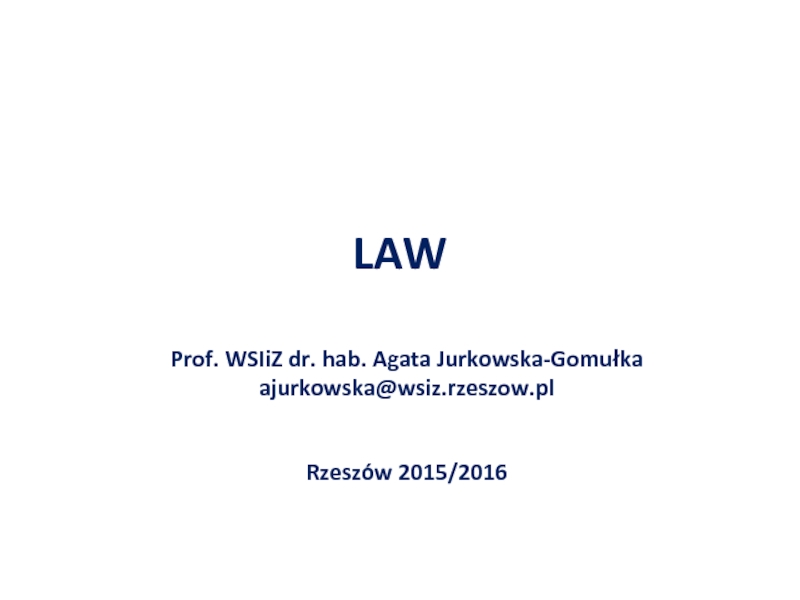
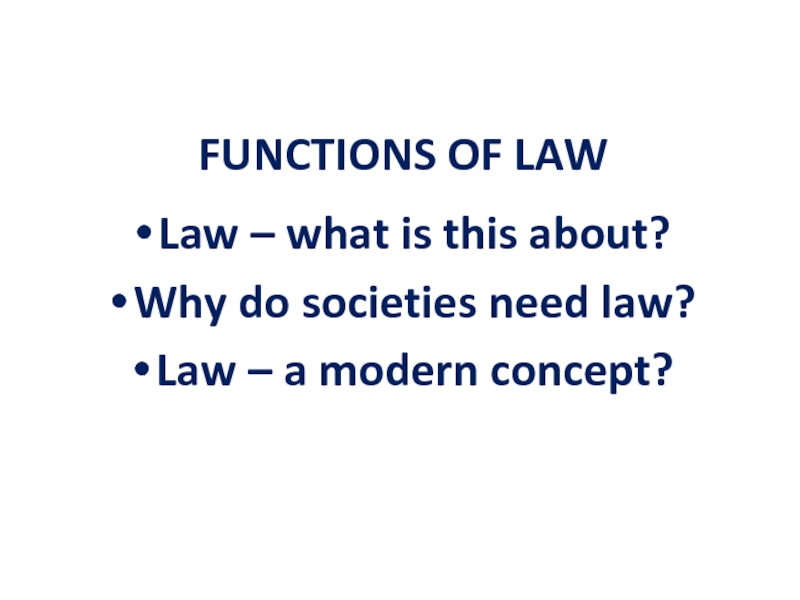
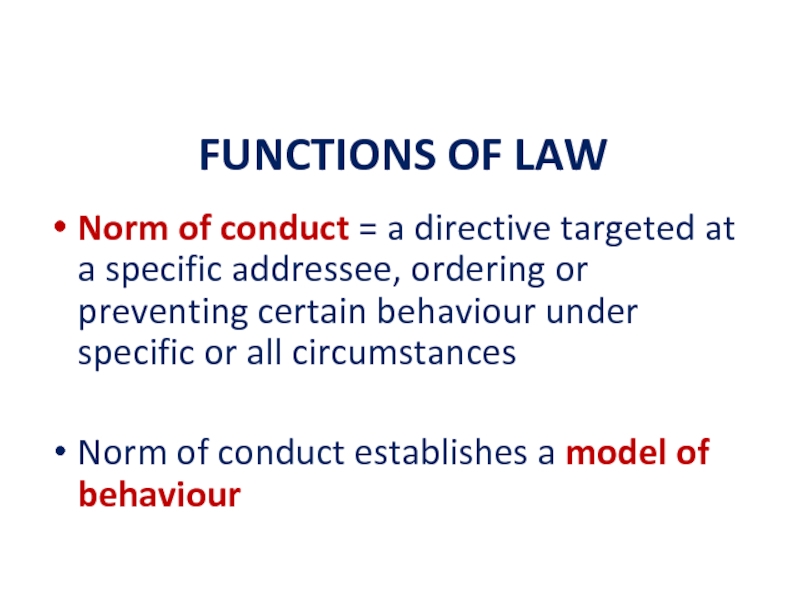
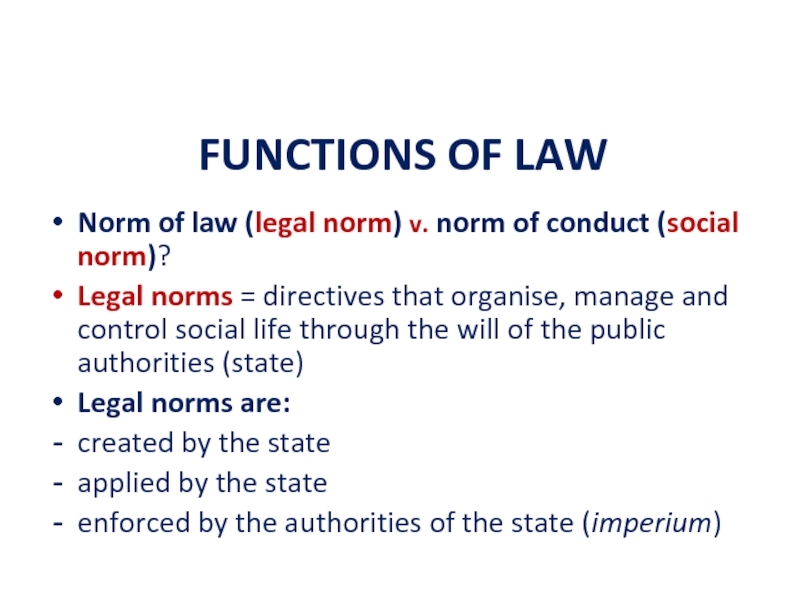
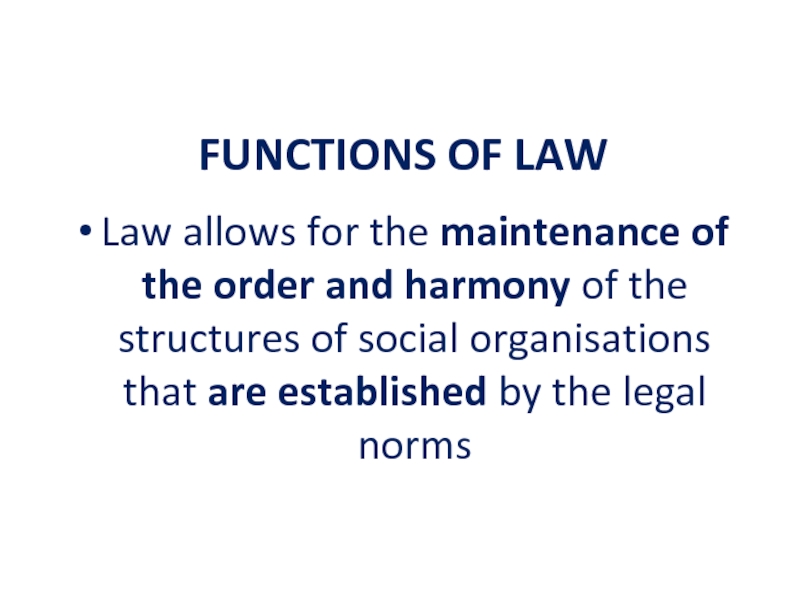
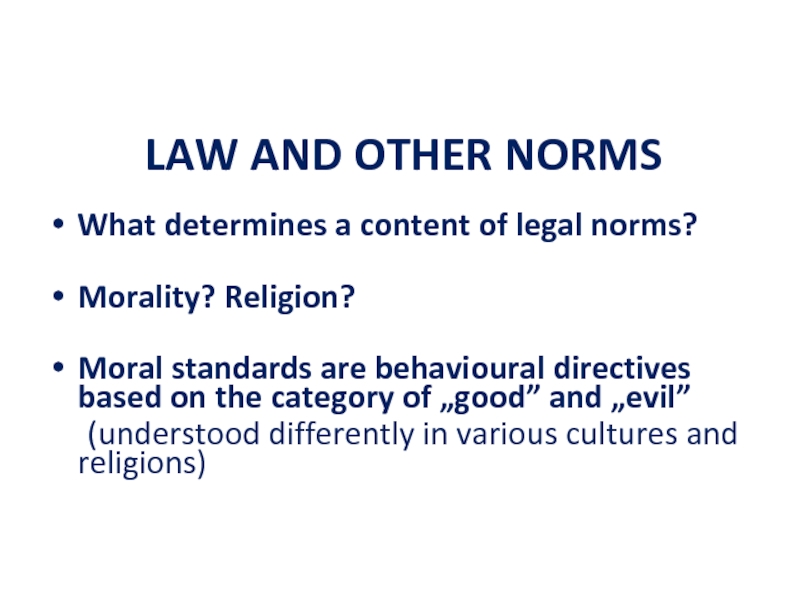
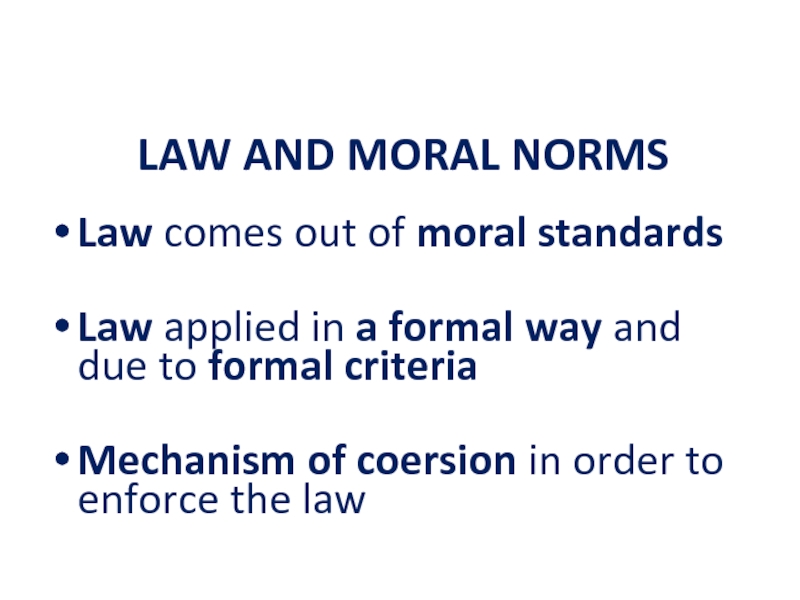
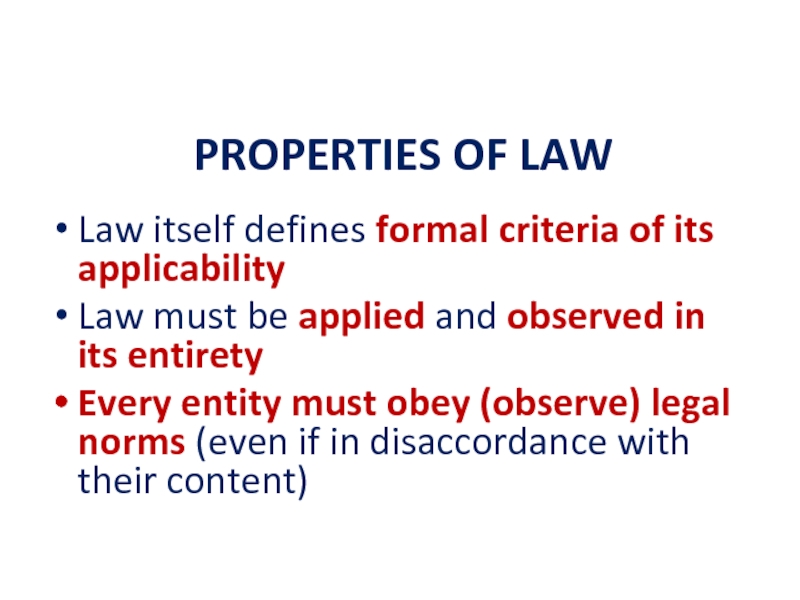
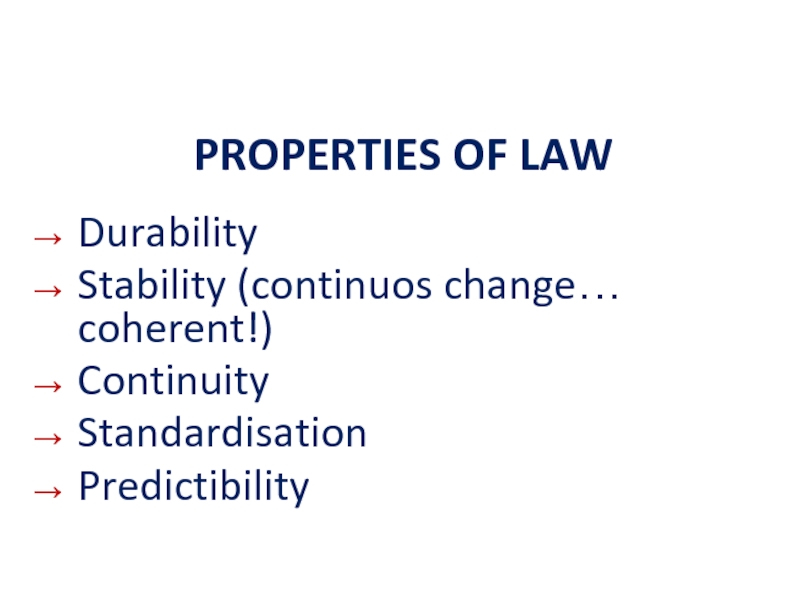
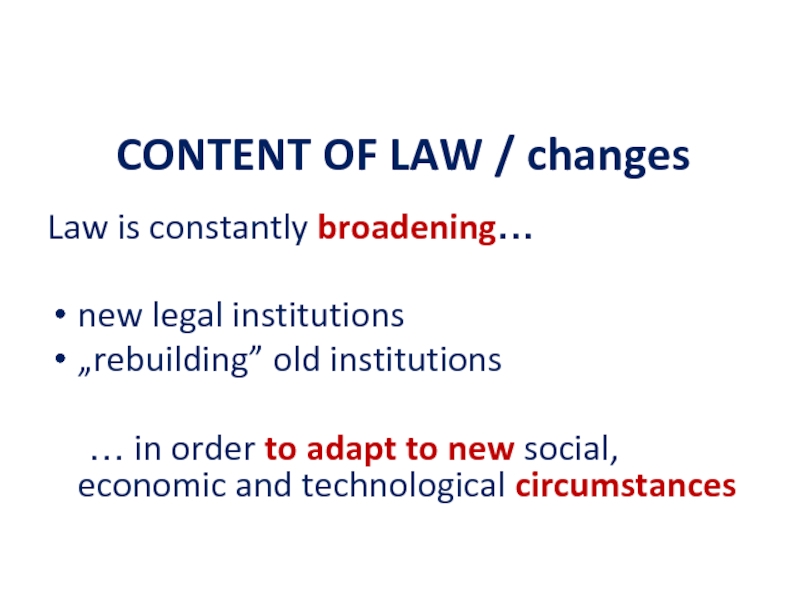
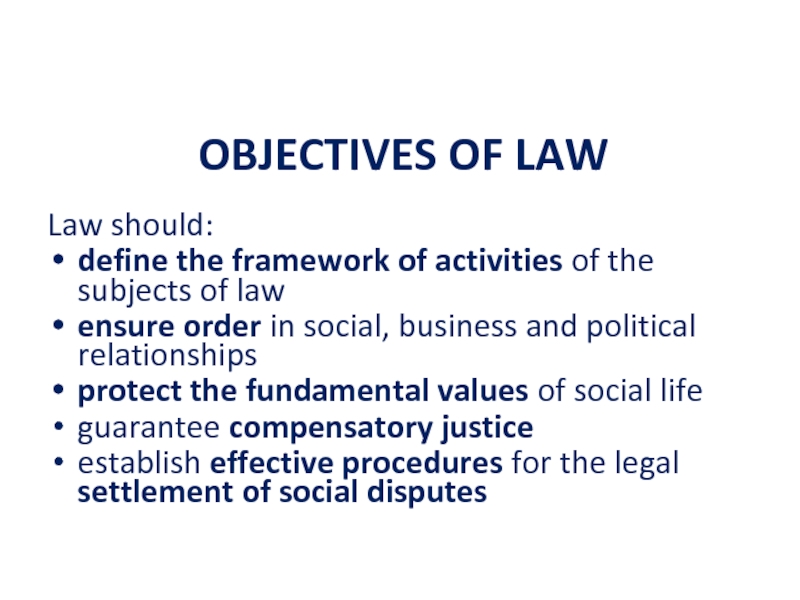
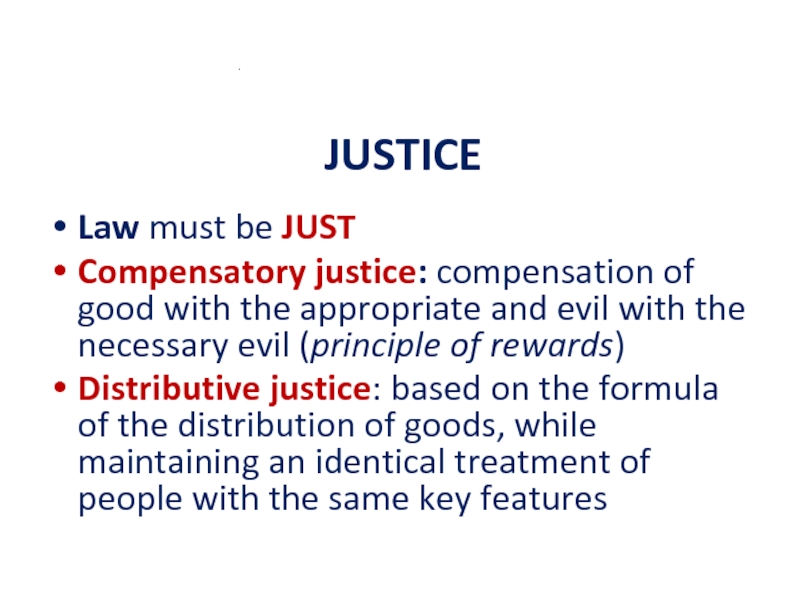
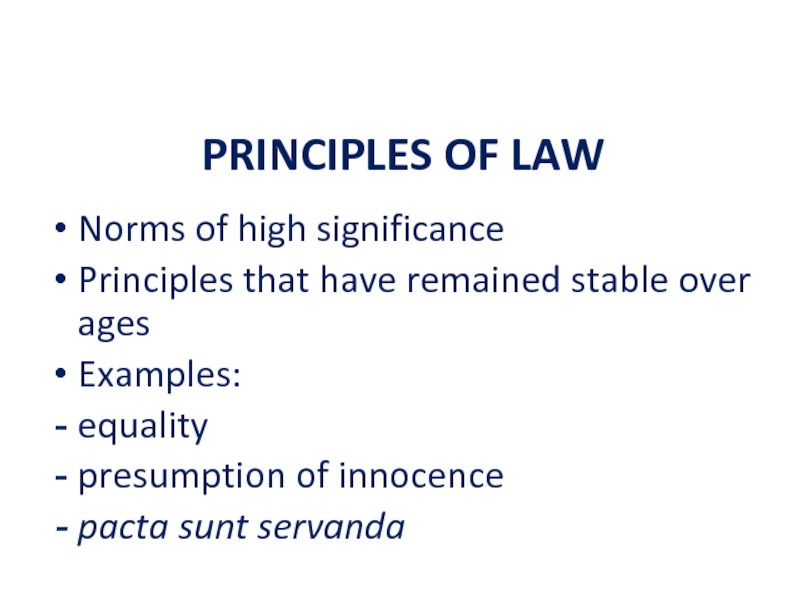
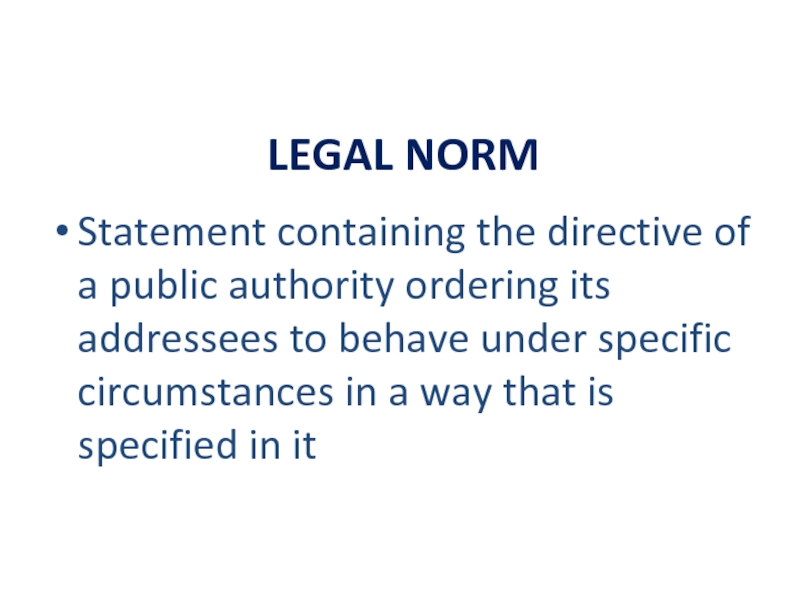
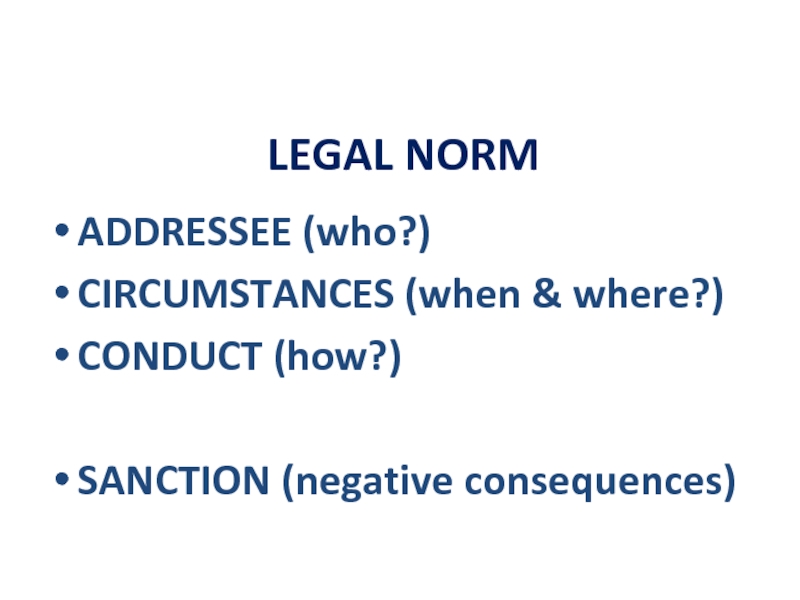
![LEGAL NORM - example§ 108. [German Civil Code] (1) If the minor concludes a contract](/img/tmb/2/192111/2147e59e4cc418814af97a22f82e6fb7-800x.jpg)
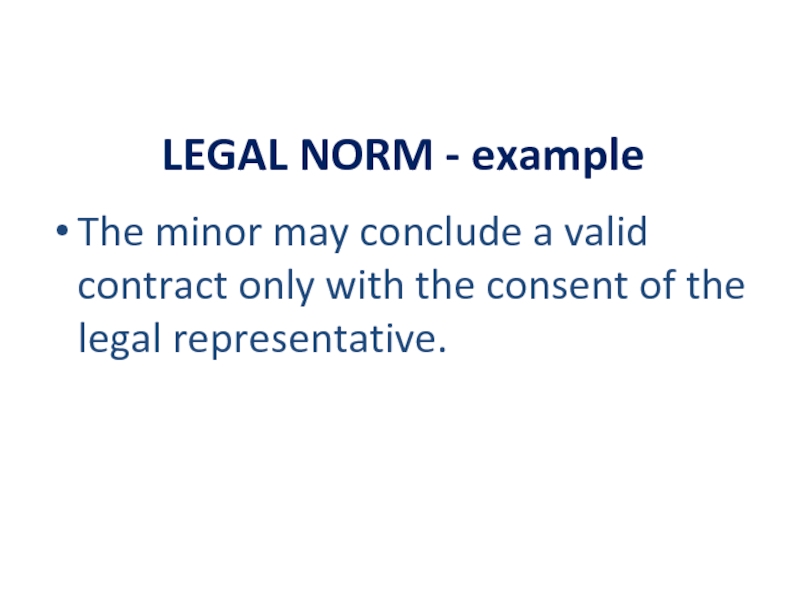
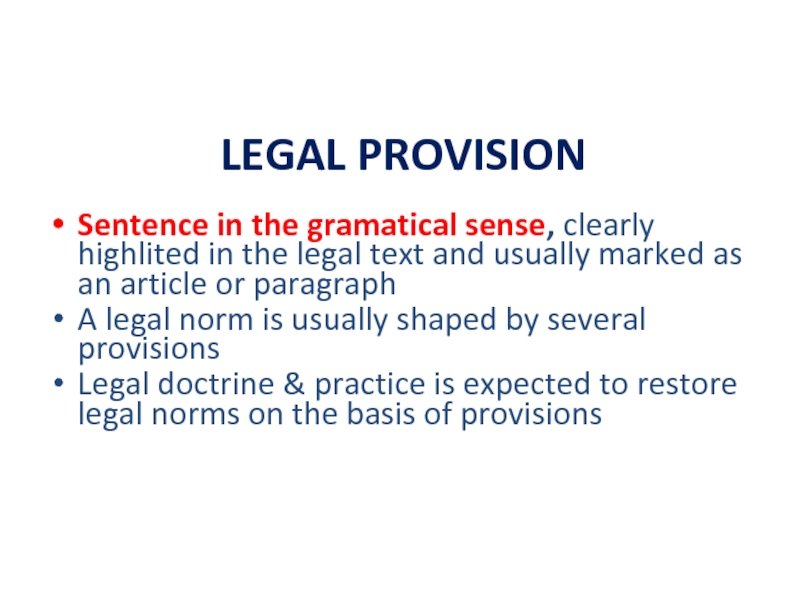
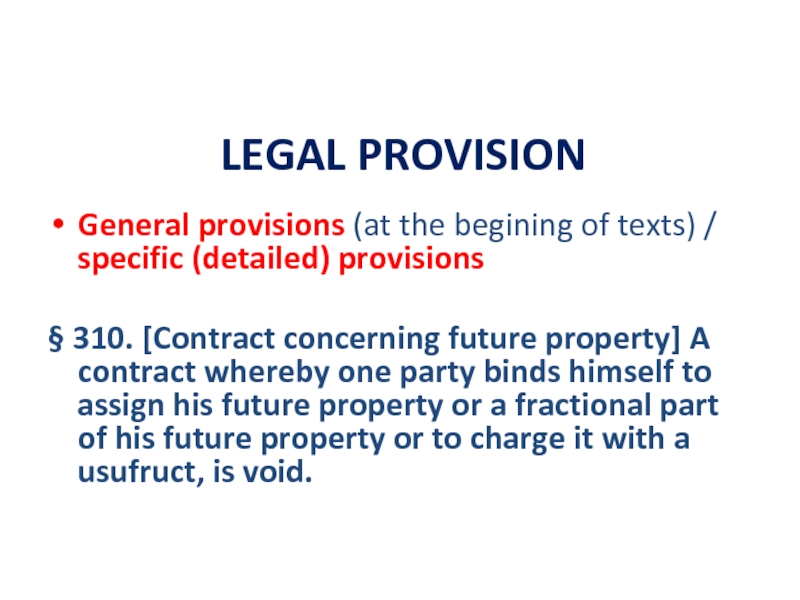
![REFERANCE LEGAL PROVISION§ 173. [German civil code] The provisions of §§ 17D, 171(2) and 172(2)](/img/tmb/2/192111/98df1fd6536c2a6c75e0e6860762f99e-800x.jpg)
![LEGAL DEFINITIONSArticle 4. [Polish competition act]For the purpose of this Act: 5)](/img/tmb/2/192111/d0f8eb5c86811c09c33a8dc75001d8b2-800x.jpg)
